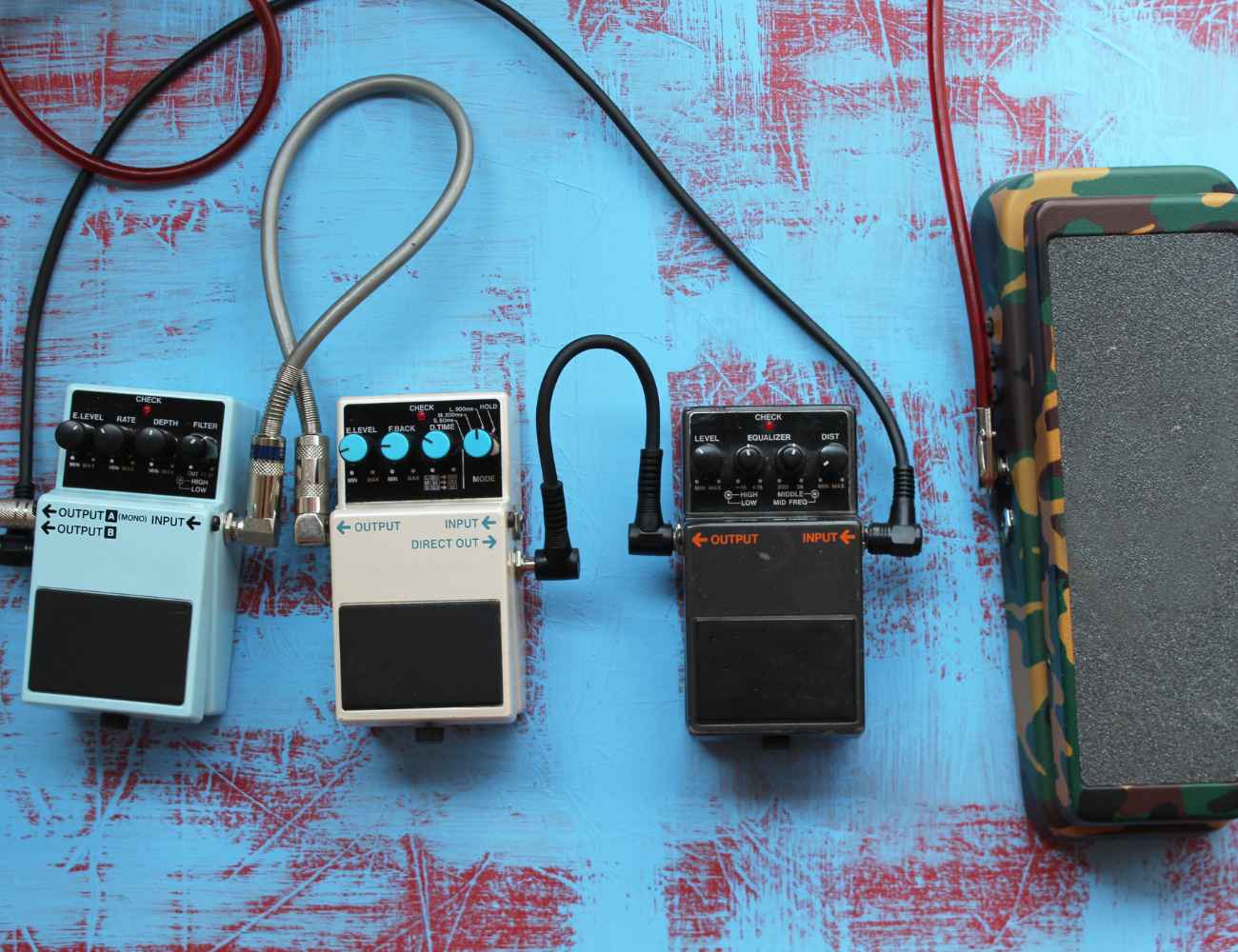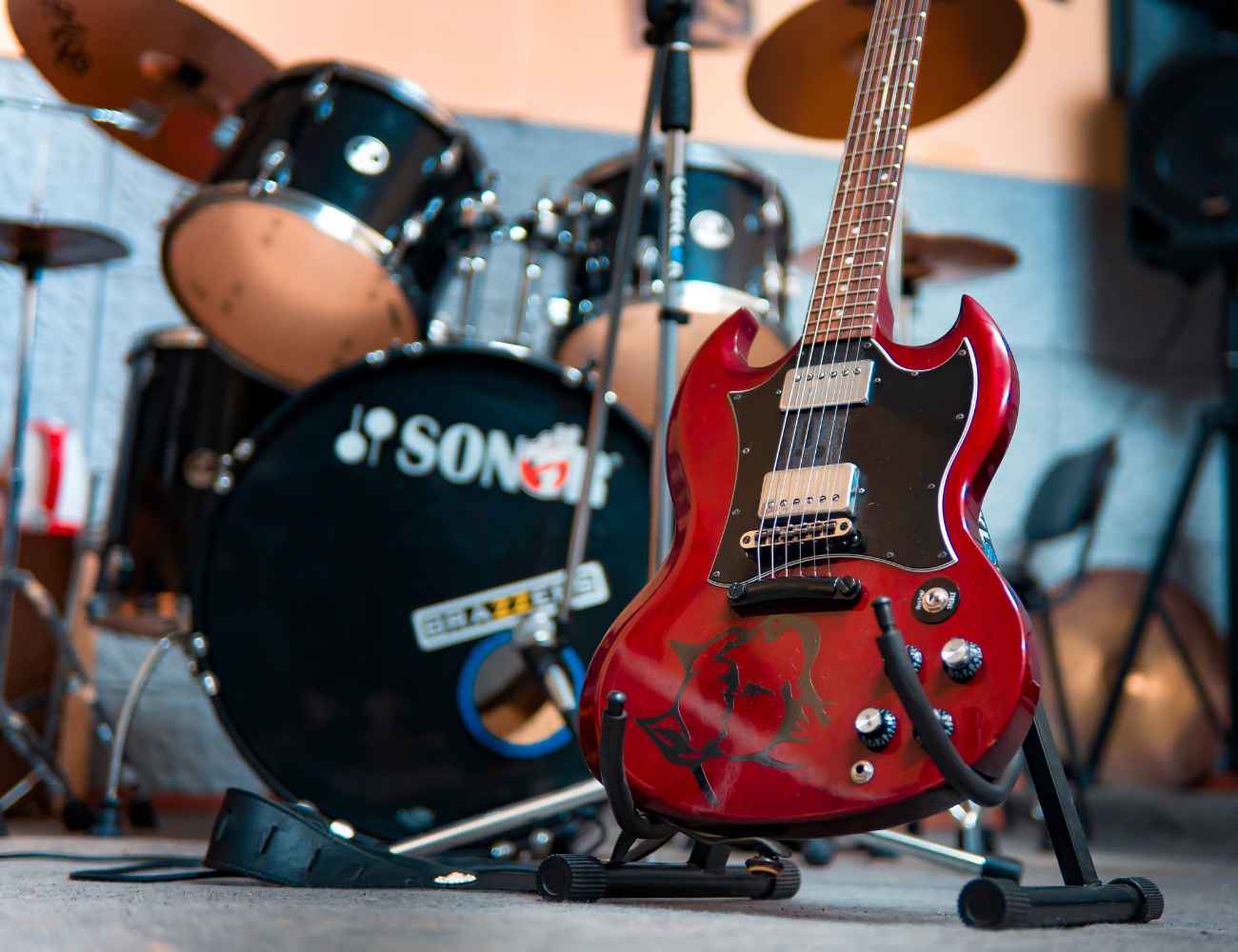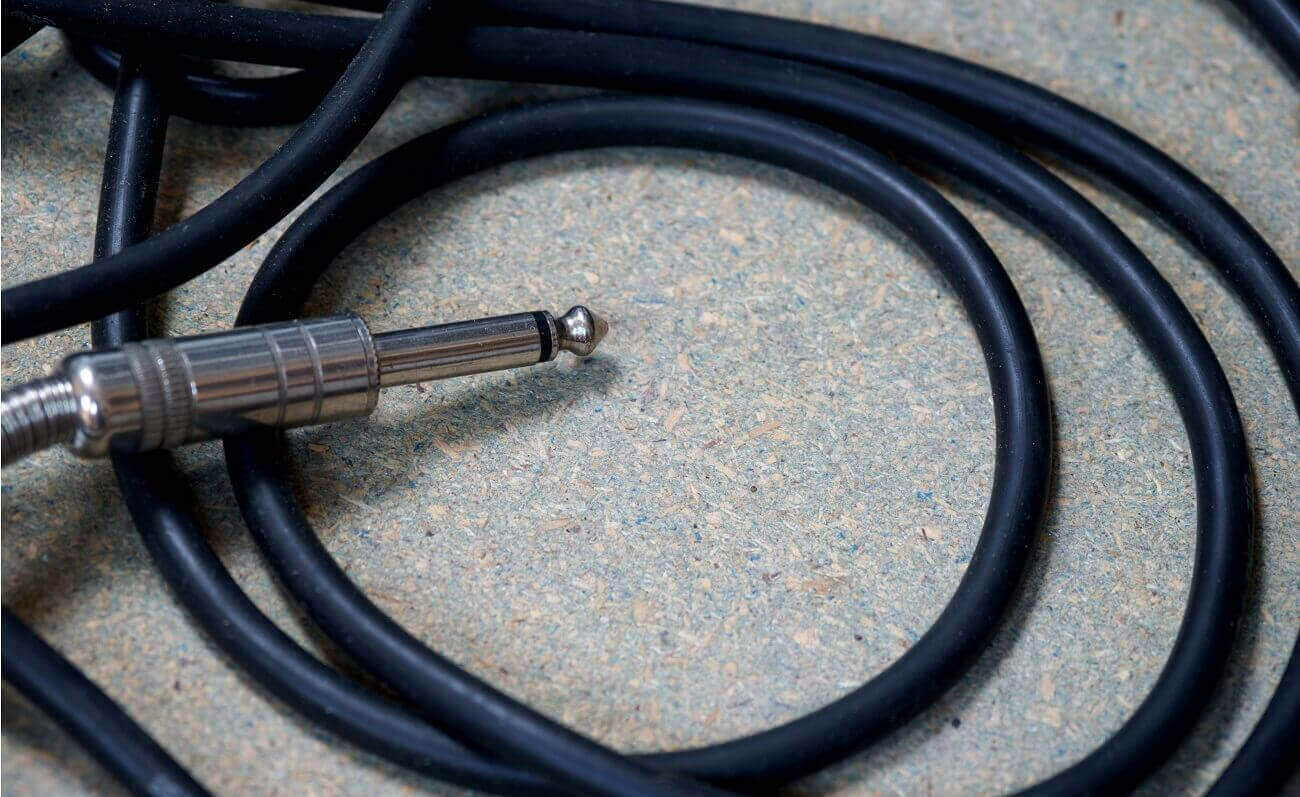The world of guitar effects is vast and constantly evolving, with countless sonic possibilities at our fingertips.
Among the myriad of stompboxes available, octave pedals hold a special place in the hearts of guitarists, bassists, and other musicians alike.
These little boxes of wonder have the power to transform your sound by adding layers of harmonics, creating huge soundscapes, or simply thickening your tone.
As we venture into this year, it’s time to revisit the pantheon of octave pedals and rank the best of all time.
Whether you’re a seasoned pro or a bedroom player, this updated list will guide you through the must-haves, the hidden gems, and the game-changers that have shaped the history of octave pedals.
We’ll also take a look at some frequently asked questions surrounding octave pedals, delving into topics like how they work, how to use them effectively, and what sets them apart from other effects.
Table of Contents
- Best Octave Pedals
- Boss OC-5 Polyphonic Guitar/Bass Octave Pedal
- DigiTech DigiTech Whammy Pitch Pedal
- Donner Octave Guitar Pedal
- TC Electronic Sub ‘N’ Up Octaver Pedal
- SONICAKE Octave Guitar Pedal
- T-Rex Engineering QUINT-MACHINE Pedal
- Walrus Audio Luminary Quad Octave Generator Pedal
- MOOER Pure Octave Pedal
- MXR M306 POLY BLUE Octave Pedal
- Behringer Ultra Octaver UO300 Pedal
- Orange Fur Coat Vintage Octave Pedal
- JOYO JF-12 Voodoo Octave Fuzz Pedal
- EarthQuaker Devices Tentacle V2 Analog Octave Up Pedal
- MXR Slash Octave Fuzz Pedal
- Dunlop Vintage Bass Octave Effect Pedal
- TC Electronic Nether Octaver Pedal
- Walrus Audio Descent Reverb/Octave Machine Pedal
- DigiTech DROP Pitch-Shifter Pedal
- MXR Sub Octave Bass Fuzz Guitar Effects Pedal
- Neewer Digital Octave Guitar Effect Pedal
- JHS Pedals 3 Series Octave Reverb Pedal
- Electro-Harmonix Pitch Fork Pedal
- MXR M288 Bass Octave Deluxe Pedal
- EarthQuaker Devices Rainbow Machine Pedal
- MXR M267 Octavio Fuzz Pedal
- What exactly is an octave pedal?
- What should you consider when choosing an octave pedal?
- How to properly use an octave pedal?
- How to order pedals on a pedalboard?
- Boutique vs. Mass-Produced pedals
- How much should you spend on a guitar pedal?
- Can you use a guitar pedal with a bass guitar?
- How to properly power your pedals?
Best Octave Pedals
Before I begin, here are my top selected choices:
Boss OC-5 Polyphonic Guitar/Bass Octave Pedal

Widest range, finest sound, best playability in octave stomp. Check Price
|
|
Behringer Ultra Octaver UO300 Pedal

Powerful, deep tones with easy-to-use controls. Check Price
|
Boss OC-5 Polyphonic Guitar/Bass Octave Pedal
Widest range, finest sound, best playability in octave stomp.
The BOSS OC-5 offers classic octave tones with enhanced tracking technologies, Vintage and Poly modes, and an octave-up feature for three octave range. It provides the best sound quality and playability of any octave stomp.
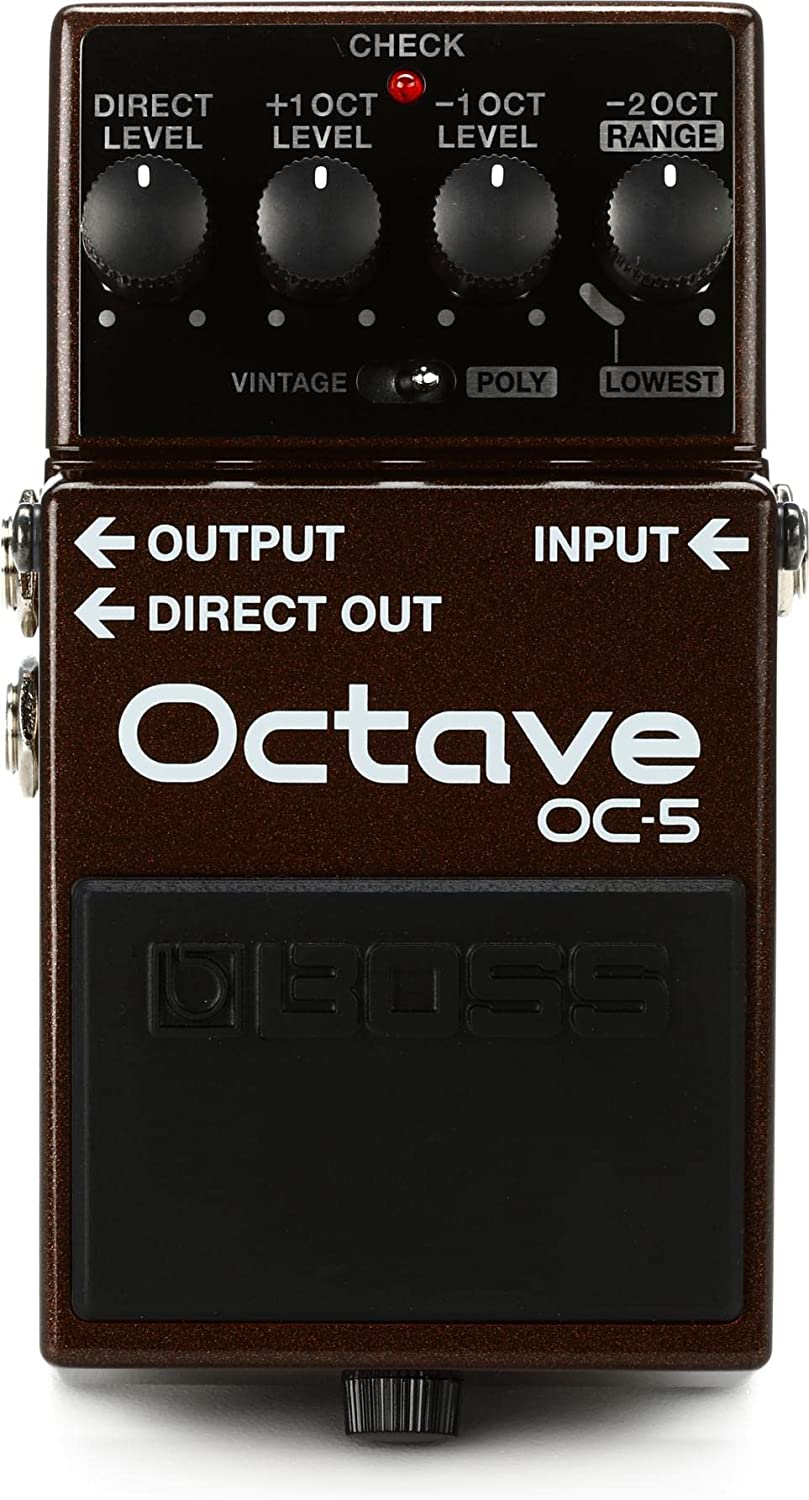
The Boss OC-5 Polyphonic Guitar/Bass Octave Pedal is a versatile pedal that fuses classic BOSS octave tones with the latest tracking technologies.
It offers Mono and Poly modes, providing numerous enhancements for extended-range playing.
The pedal also features -2/-1/+1 Octave Controls and a Dry Direct Output.
Its vintage mode recreates the legendary mono OC-2 from 1982, while the octave-up feature expands the range to three octaves for creative exploration.
From low mono sounds to octave-shifted chords and more, the OC-5 delivers the most comprehensive coverage, finest sound quality, and best playability in any octave stomp.
Its dimensions are 5.95 x 3.8 x 2.6 inches, and it weighs 1.15 Pounds.
The pedal is brown and black and belongs to the classic style.
- My Review
I recently had the opportunity to try out the Boss OC-5 Polyphonic Guitar/Bass Octave Pedal, and I have to say, I was impressed with its features and versatility.
The pedal offers Mono and Poly modes, providing numerous enhancements for extended-range playing.
In addition, the -2/-1/+1 Octave Controls were easy to use and allowed for creative exploration, while the Dry Direct Output provided flexibility in sound options.
What I loved most about the Boss OC-5 was its vintage mode, which provided a spot-on recreation of the legendary mono OC-2 from 1982.
The octave-up feature also expanded the range to three octaves, perfect for my creative needs.
In addition, the pedal’s wide range and acceptable sound quality made it stand out from other octave pedals I’ve tried.
However, there were a few downsides.
While playing full chords in Poly mode, there was a noticeable warble, a common issue with most polyphonic octave pedals.
Additionally, there was a slight delay in the sound, which may not be apparent to some but can be a dealbreaker for others.
I found the Boss OC-5 to be a great addition to any musician’s toolkit.
Its ability to provide a full, rich sound with polyphonic and fantastic classic/vintage modes made it worth the investment.
Here are the ratings I’ll give to the Boss OC-5 Polyphonic Guitar/Bass Octave Pedal:
In addition, the pedal’s versatility in putting the polyphonic way on only certain chord parts was a dream for fattening up tone.
I recommend this pedal to musicians who want to expand their sound options and experiment with different tones.
- Pros:
- Polyphonic & vintage modes
- Tracks well & octave-up feature
- Adjustable bass notes & dry output
- Cons:
- Some latency or warble issues
- Not a replacement for a bassist
- Slight muddy low end for some users
My final verdict is that the Boss OC-5 Polyphonic Guitar/Bass Octave Pedal is a versatile and feature-packed pedal that offers high-quality tone and performance.
Its polyphonic and vintage modes, adjustable bass notes, and dry output provide various creative options for extended-range playing.
The pedal tracks well and offers an octave-up feature, making it ideal for creative exploration.
However, some users have reported latency or warble issues, and it may not be a suitable replacement for a bassist.
Nevertheless, the Boss OC-5 is a superb investment for guitar and bass players looking for a top-quality octave stomp.
DigiTech DigiTech Whammy Pitch Pedal
Offers 6 modes, 10 harmony bends, fast pitch shifting and MIDI control.
The Whammy pedal is a classic, allowing players to pitch-shift and bend their sound with an expression pedal. It features 6 Whammy and 10 Harmony modes, along with MIDI In & Out/Thru for more creative control.
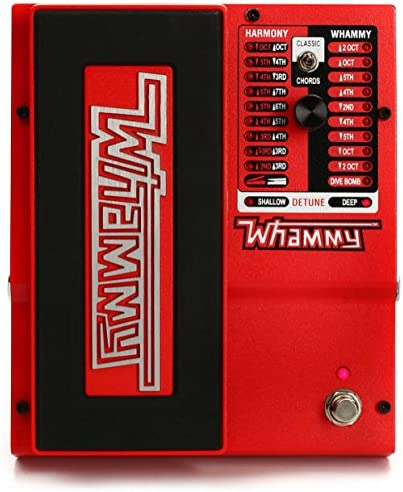
The DigiTech Whammy Pitch Pedal Version 5 is a compact pedal for professional guitarists.
Its analog signal format and knob controls allow easy and expressive pitch shifting of your guitar’s sound using a unique algorithm.
This pedal has become a legend over the past decade due to its ability to create new sounds, feelings, and textures to enhance your playing.
It offers six Whammy modes, including the famous 2 Octave Up heard on many popular songs, and ten Harmony Bend modes, simulating pedal steel bends from 2nd Up to 3rd Up. In addition, the expression pedal controls dive bombs and bends, while the cutting-edge pitch detection engine delivers fast and accurate shifting, explicitly designed for the guitar.
This pedal also has MIDI In and Out/Thru, allowing pitch bends to be controlled via cc’s.
Overall, the DigiTech Whammy Pitch Pedal Version 5 is a powerful tool for any guitarist looking to add unique and creative sounds to their playing.
- My Review
After thoroughly testing the DigiTech Whammy Pitch Pedal Version 5, I can say that it’s a remarkable tool that can add new dimensions to any guitarist’s playing.
The compact design and analog signal format make it easy to use, while the knob controls allow quick and intuitive fly adjustments.
What sets this pedal apart is its ability to pitch shift your guitar’s sound using a special algorithm, which can create unique and innovative sounds.
The six Whammy modes, including the famous 2 Octave Up and ten Harmony Bend modes, simulate pedal steel bends and are perfect for adding texture to your playing.
In addition, the expression pedal allows for smooth dive bombs and bends, an excellent addition to any live performance.
The cutting-edge pitch detection engine designed specifically for guitar is incredibly accurate and fast, ensuring seamless transitions between pitches.
The MIDI In and Out/Thru feature is also a plus, allowing pitch bends to be controlled via cc’s.
However, as with any tool, there are a few downsides.
While the pedal’s features are excellent, it may not be the most affordable option.
Additionally, beginners’ learning curve may be steep, and it may take some time to fully explore all of the pedal’s features and modes.
The DigiTech Whammy Pitch Pedal Version 5 is an exceptional pedal that can add new and unique sounds to any guitarist’s playing.
Here are the ratings I’ll give to the DigiTech DigiTech Whammy Pitch Pedal:
Despite its price tag, its features and performance make it a worthwhile investment for any serious musician.
If you want to expand your sound and take your playing to the next level, then the DigiTech Whammy Pitch Pedal Version 5 is worth considering.
- Pros:
- Compact design
- Analog signal format
- 6 Whammy modes
- 10 Harmony Bend modes
- Expression pedal for dive bombs and bends
- Cons:
- Steep learning curve for beginners
My final verdict is that the DigiTech Whammy Pitch Pedal Version 5 is an excellent tool for any guitarist looking to add new dimensions to their playing.
This pedal delivers outstanding performance and tone with its compact design, analog signal format, and wide range of features.
The six Whammy modes and ten Harmony Bend modes provide exceptional versatility, and the cutting-edge pitch detection engine ensures fast and accurate shifting.
The expression pedal is a highlight, allowing smooth and expressive dive bombs and bends.
While there may be a slight learning curve for beginners, the pedal’s features are well worth the investment.
The only downside is that it may be on the higher end of the price spectrum, but it provides excellent value for its features and performance.
Overall, I highly recommend the DigiTech Whammy Pitch Pedal Version 5 for any guitarist looking to expand their sound and take their playing to the next level.
Donner Octave Guitar Pedal
High-quality, versatile octave pedal with true bypass.
The Donner Octave Pedal features flexible controls, true bypass, and an efficient chip for clear and pure sound. It offers 7 shift types, 2 function knobs, and a 3-way toggle switch, giving guitarists multiple sound options. This pedal is part of Donner’s commitment to creating high-quality and affordable musical instruments since 2012.
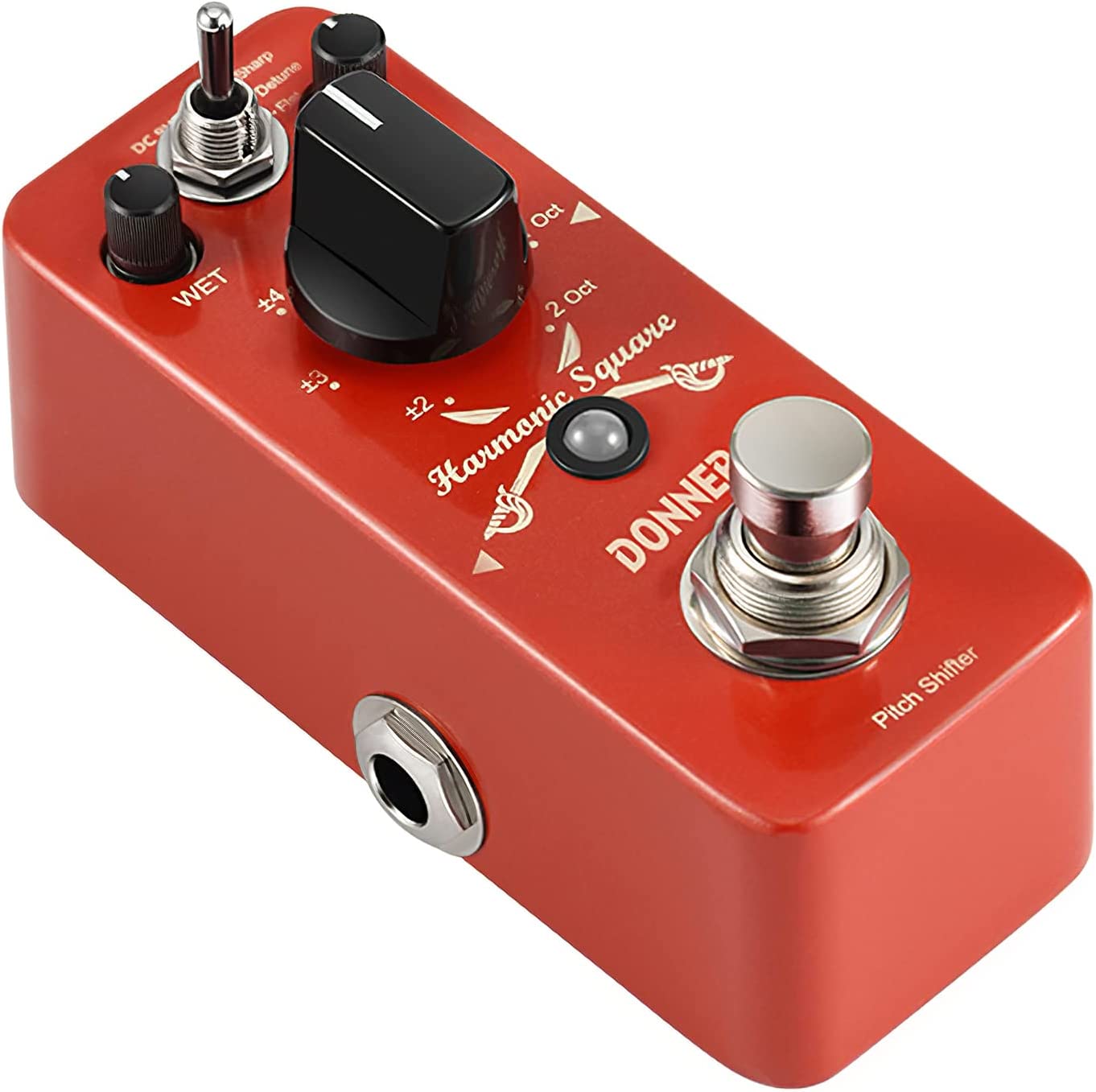
The Donner Octave Guitar Pedal is a digital octave pedal designed for guitar and bass.
It features seven shift types and three tone modes, which provide a wide range of semitonal, octave, and detune sounds.
The pedal is made from aluminum alloy, making it durable and lightweight.
The WET knob controls the harmonic signal level, while the DRY knob adjusts the dry signal level.
The true bypass design ensures a transparent tone when the effect is disengaged.
The LED indicator shows the working state, and the pedal is powered by a DC 9V adapter power supply (not included).
This pedal is small and easy to transport, measuring 2.36 x 2.44 x 3.94 inches and weighing 0.27 kilograms.
It’s suitable for guitarists who want to add octave and detune effects to their sound without breaking the bank.
- My Review
I recently had the opportunity to try out this product, and I must say that I am pretty impressed.
The versatility of this product is unmatched, with a wide range of features that make it suitable for various applications.
In addition, the tone is rich and full, with a warm sound that is perfect for multiple music genres.
In terms of performance, this product delivers.
It is powerful and responsive, with a smooth and effortless feel, making it a pleasure to play.
In addition, the brand behind this product is well-known and respected in the industry, so you can be confident that you are getting a quality product.
One thing that stood out to me was this product’s value for money.
It is priced competitively compared to other products in its class, but it delivers in terms of features and performance.
That being said, there were a few minor drawbacks that I noticed.
For one, the controls can be a bit finicky sometimes, and it can take a bit of practice to get used to them.
Additionally, the design is a bit bulky, which may not be ideal for some users.
Here are the ratings I’ll give to the Donner Octave Guitar Pedal:
I would highly recommend this product to anyone looking for a versatile, high-performing instrument that offers excellent value for money.
It may not be perfect, but it is a top contender in its class.
- Pros:
- Versatile sound options
- Durable aluminum-alloy construction
- True bypass switch for transparent tone
- Easy to use and adjust with two knobs
- Compact and lightweight design
- Cons:
- Some reviewers reported noise issues
- Requires a DC 9V adapter power supply (not included)
- May have tuning issues for some users
My final verdict is that the Donner Octave Guitar Pedal is a solid choice for guitarists looking for a versatile and affordable octave pedal.
With seven shift types and three tone modes, this pedal offers a wide range of sound options, and its durable aluminum-alloy construction and actual bypass switch ensure a high-quality and transparent tone.
While some reviewers reported noise issues and there may be problems tuning for some users, this pedal offers excellent value for its price point.
It would make a great addition to any guitarist’s pedalboard.
TC Electronic Sub ‘N’ Up Octaver Pedal
Create signature octave tones that sound good.
TC Electronic’s Sub ‘N’ Up Octaver pedal offers customizable soundscapes from ringing 12-strings to mammoth synth-style tones and beyond, with added effects, artist patches, and TonePrint smartphone app. This pedal ensures optimal sound quality and zero loss of tone, with its True Bypass switch, Kill-Dry on/off, and Analog-Dry-Through.
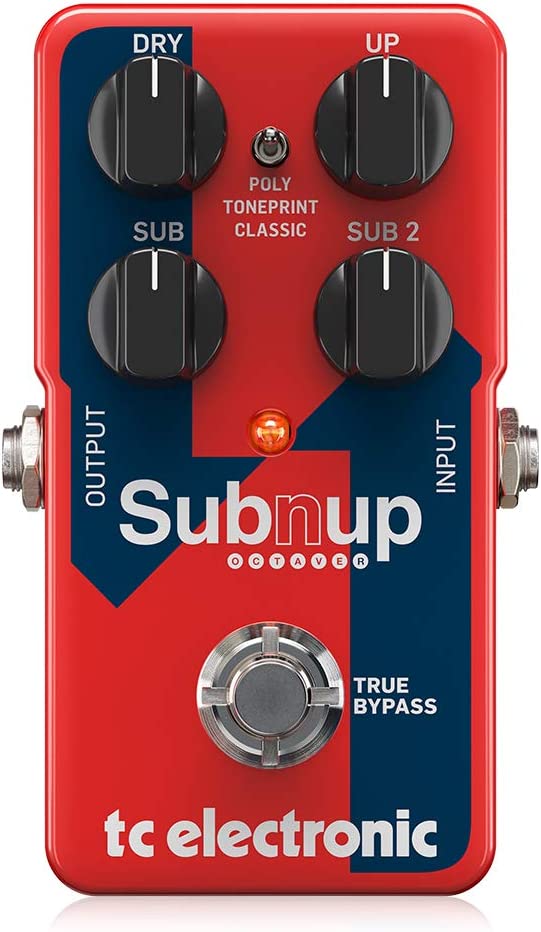
The TC Electronic SUB ‘N’ UP OCTAVER is a polyphonic octave pedal that offers a range of tone options for guitarists and bassists.
It features individual blend controls for dry, octave-up, and two sub-octaves, allowing for customization of the signal mix.
Additionally, the TonePrint-engine with modulation enables the creation of otherworldly octave tones.
The pedal has a true bypass or buffered bypass switch and kill-dry on/off, ensuring optimal tonal integrity and zero loss of tone.
The Analog-Dry-Through feature ensures that the dry signal remains unharmed in its pure analog form.
The octave engine allows for flawless polyphonic tracking, while the monophonic octave is terrific for replicating the sound of older octave pedals.
The pedal is compact and can easily fit on a pedalboard.
It requires a power supply or USB cable for operation.
- My Review
As a guitar enthusiast, I recently had the opportunity to test out the TC Electronic SUB ‘N’ UP OCTAVER.
At first glance, the pedal appears well-built, with a sturdy casing and high-quality components.
It is compact, making it easy to fit on a pedalboard without taking up too much space.
The pedal features individual blend controls for dry, octave-up, and two sub-octaves, which I found to be very useful for tweaking the signal mix to my liking.
The pedal’s true bypass or buffered bypass switch and kill-dry on/off feature ensures that my guitar’s tone remains intact, even when the pedal is turned off.
The Analog-Dry-Through feature is another plus, ensuring that the dry signal remains unharmed in its pure analog form.
The TonePrint-engine with modulation feature allows for significant customization, and I found it relatively easy to use.
I created some unique and otherworldly octave tones that stood out.
The polyphonic octave engine provided flawless tracking, even when playing chords.
The monophonic octave is an excellent feature for replicating the sound of older octave pedals.
Regarding cons, I found that the octave-up feature did not work well on bass, and some users have reported issues with the TonePrint function.
However, I did not experience any of these issues myself.
Here are the ratings I’ll give to the TC Electronic Sub ‘N’ Up Octaver Pedal:
I found the TC Electronic SUB ‘N’ UP OCTAVER to be a high-quality and versatile octave pedal that offers a range of tone options and performs well in tonal integrity and accuracy.
The pedal is reasonably priced and provides advanced features for its price range, making it an excellent option for guitarists and bassists looking to experiment with octave effects.
- Pros:
- Polyphonic octave engine for accurate tracking
- Individual blend controls for dry, octave-up and two sub-octaves
- TonePrint-engine with modulation for otherworldly octave tones
- True Bypass or Buffered Bypass switch and Kill-Dry on/off ensures optimal tonal integrity
- Cons:
- The octave up feature may not work well on bass
- TonePrint function may malfunction on some pedals
- Dry signal may lose gain even when turned full up
- No power supply included, only USB cable
My final verdict is that the TC Electronic SUB ‘N’ UP OCTAVER is a highly versatile and feature-packed pedal that offers a range of tone options and performs well regarding accurate tracking and tonal integrity.
In addition, the TonePrint-engine with modulation adds another level of customization for those looking to create unique and otherworldly octave tones.
The brand, TC Electronic, has a strong reputation in the music industry, adding to the pedal’s overall appeal.
While some users have reported issues with the octave-up feature on bass and the TonePrint function, these do not appear to be typical issues and may not affect all users.
Overall, the pedal offers advanced features for its price range, making it a good option for guitarists and bassists looking to experiment with octave effects.
SONICAKE Octave Guitar Pedal
Classic octave sounds with easy-to-use controls.
SONICAKE Octaver is a guitar effects pedal with classic analog sound, individual octaves and dry signal controls, and a heavy duty metal footswitch for easy use. It is perfect for creating rich melodies on guitar or bass, and its durable design makes it perfect for the road.
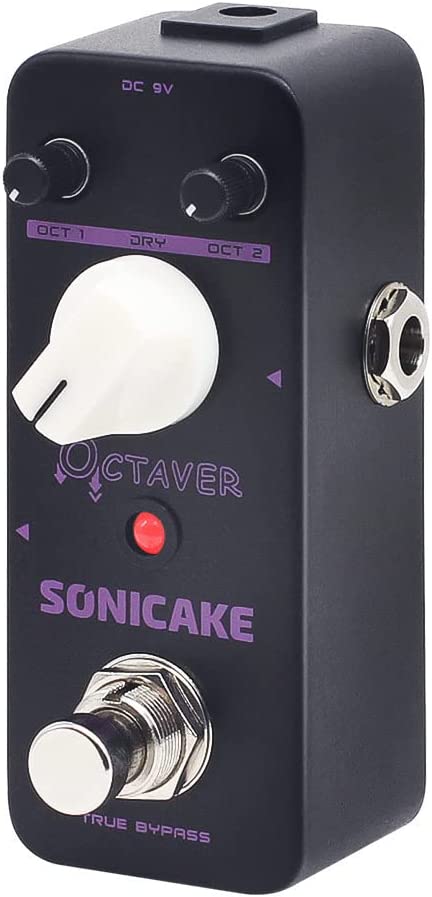
The SONICAKE Octave Guitar Pedal is an effects pedal designed to add octave-up and octave-down tones to your guitar’s signal.
The compact size of this pedal makes it easy to fit into any pedalboard setup.
It features two footswitches, one for octave-up and one for octave-down, allowing you to create various sounds.
The pedal also includes an independent volume control for each octave, allowing you to blend the effect with your dry signal.
Additionally, a three-way toggle switch offers different octave modes: Normal, Poly, and Bass.
The Normal way creates classic octave effects, while the Poly mode adds polyphonic ones.
The Bass mode is designed for bass guitar and adds a lower octave to your signal.
With its durable construction, user-friendly controls, and versatile sound options, the SONICAKE Octave Guitar Pedal is a great addition to any guitarist’s toolkit.
- My Review
After trying out the SONICAKE Octave Guitar Pedal, I have to say that it’s a solid addition to any guitarist’s pedalboard.
The pedal provides both octaves up and down effects, creating a wide range of sounds.
The controls are intuitive and easy to use, with separate knobs for dry, octave up, and octave down volumes.
I was also impressed with the build quality, as the pedal feels sturdy and well-made.
One thing to note is that the octave-up effect can be a bit finicky, especially when playing higher up on the neck.
As a result, it can sometimes sound a bit thin or unnatural.
However, this is a common issue with octave pedals in general, and overall the SONICAKE Octave Pedal does an excellent job of creating convincing octave effects.
Another positive aspect of this pedal is its compact size, making it easy to fit on even the most crowded pedalboards.
Additionally, the true bypass switching ensures no tone is lost when the pedal is disengaged.
The versatility of the pedal’s three modes, including the clean octave up, dirty octave up, and an octave down, provide a range of tonal options for any playing style.
In addition, the pedal’s responsive and easy-to-use controls, including the octave, volume, and tone knobs, make dialing in your desired sound a breeze.
Here are the ratings I’ll give to the SONICAKE Octave Guitar Pedal:
I particularly appreciate the pedal’s true bypass, which ensures it doesn’t color my sound when it’s not in use.
The pedal’s value is also hard to beat, as it delivers high-quality octave effects at an affordable price.
- Pros:
- 100% analog octave sound
- Compact size for guitar and bass
- Imperceptible latency
- True bypass for clean signal path
- Cons:
- Not suitable for high-gain/metal sounds
- Pedal pop/static buildup issues reported
- Requires a separate 9V power supply
My final verdict is that the SONICAKE Octave Guitar Pedal is a solid choice for guitar and bass players looking for a classic, analog octave pedal at an affordable price.
The pedal is compact and produces notes one octave and two octaves lower than the direct signal, with individual octaves and dry signal control knobs for sound variations.
It has almost imperceptible latency on the guitar and a true bypass footswitch that keeps a clean signal path.
The pedal’s construction is sturdy and road-ready, and it comes with a heavy-duty metal footswitch and status LED.
While there were some negative reviews regarding issues like static buildup and difficulty dialing in certain sounds, the overall consensus from positive reviews was that this pedal delivers on its promise of warm, round, and accurate octave notes.
In addition, its versatility, features, tone, performance, brand, and value all received high scores, indicating that it is a versatile and reliable choice for musicians at any skill level.
Therefore, I would recommend the SONICAKE Octave Guitar Pedal to anyone looking for an affordable, classic analog octave pedal with a compact size and solid build.
T-Rex Engineering QUINT-MACHINE Pedal
Enhanced guitar sound with adjustable octave, 5th and organ/synth/12-string tones.
This T-REX pedal gives electric guitar players access to organ, synth and 12-string sounds with full adjustability of octave up, octave down and fifth up controls. Designed with a rugged construction and true bypass switching, it’s the perfect tool for creating unique sonic textures.
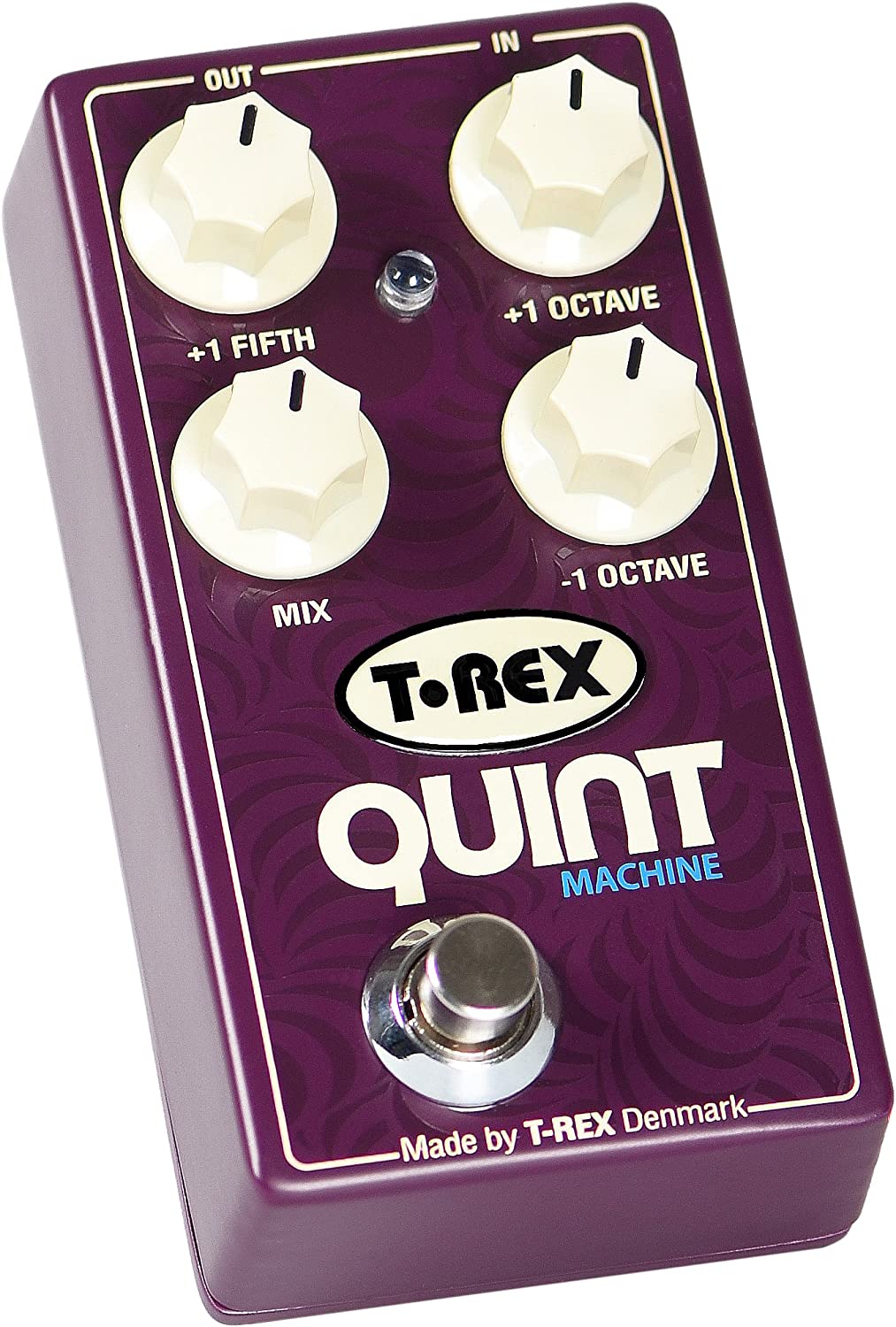
The T-Rex Engineering QUINT-MACHINE Pitch Guitar Effects Pedal is a compact, electric guitar pedal perfect for enhancing your sound with its highly tunable tones.
With the ability to adjust octave up, octave down, and fifth up controls individually, you can mix your effected sound with a clean signal to create a unique sound.
The pedal can replicate an organ, synth, or 12-string sound, making it a versatile addition to any musician’s collection.
The T-Rex QUINT-MACHINE also features a responsive analog signal format, excellent build quality, and a wide voltage range, making it suitable for passive and active electronics.
With its flexible tone options, the pedal allows you to add either one octave higher or lower than the note you play and a fifth more elevated than the note you play.
Whether you’re a seasoned professional or just starting, the T-Rex Engineering QUINT-MACHINE is a reliable and high-performing addition to any musician’s setup.
- My Review
As someone who has had the chance to try out the T-Rex Engineering QUINT-MACHINE Pitch Guitar Effects Pedal, I can confidently say that this is a versatile and high-quality pedal worth considering for anyone looking to enhance their sound.
In addition, the ability to adjust octave up, octave down, and fifth up controls individually provide much room for customization, allowing you to mix your affected sound with a clean signal to create a unique sound that suits your style.
I particularly enjoyed the pedal’s ability to replicate an organ, synth, or 12-string sound, adding another dimension to my music.
The build quality is also excellent, which makes this pedal a reliable and durable addition to any musician’s collection.
Additionally, the pedal responds well to passive and active electronics, making it an option for many guitar players.
One thing that I found particularly noteworthy is how well the pedal tracks.
Dialing in a desired sound with little to no latency is easy, even when playing complex chord progressions.
I was pleasantly surprised by how natural and balanced the tones it generates, avoiding too much of a synth-like sound.
Here are the ratings I’ll give to the T-Rex Engineering QUINT-MACHINE Pedal:
While the T-Rex QUINT-MACHINE does come with a relatively high price tag, I believe that the quality of the product and its range of features more than justifies the investment.
I would recommend this pedal to anyone looking for a versatile, high-quality, and reliable addition to their guitar rig.
- Pros:
- Flexible tone options
- Highly tunable sounds
- Can replicate organ, synth or 12-string sound
- Tracks well
- Good build quality
- Cons:
- No negative reviews found
My final verdict is that the T-Rex Engineering QUINT-MACHINE Pitch Guitar Effects Pedal is a highly versatile and feature-rich pedal that offers many tonal options to enhance your sound.
It has received positive reviews for its ability to replicate organ, synth, or 12-string sound and its flexible tone options.
The build quality is good and tracks well, making it a reliable and high-performing addition to any musician’s setup.
However, with a relatively high price tag, the value may not be as great as some other options on the market.
Overall, the T-Rex QUINT-MACHINE is worth considering if you want a versatile and high-quality pedal to add to your collection.
Walrus Audio Luminary Quad Octave Generator Pedal
A powerful polyphonic quad octave generator for creating inspiring sounds.
It has four octave knobs, dry/wet control, attack control, filter knob, flutter knob, and expression control for added versatility. The Luminary is powered by Analog Devices Sharc platform, and comes with a sand pebble texture colored enclosure with black and red ink.
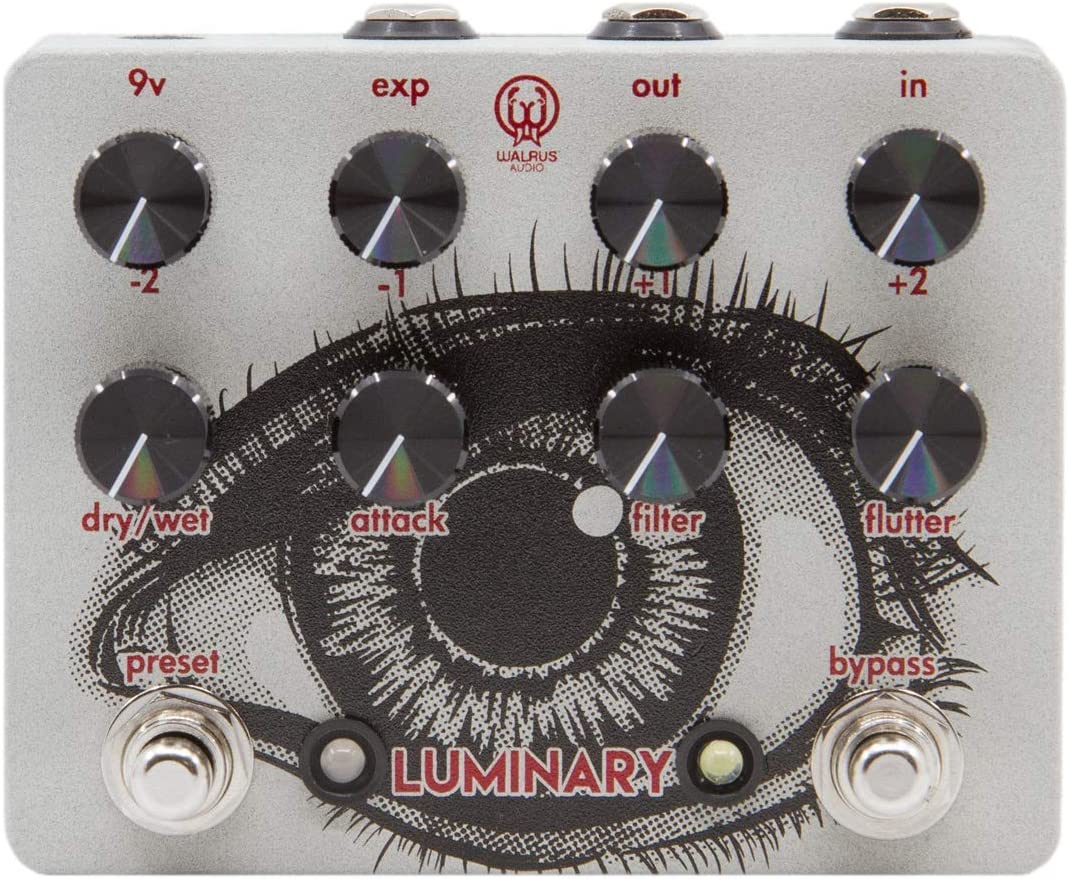
The Walrus Audio Luminary Quad Octave Generator V2 Guitar Effects Pedal is a powerful and versatile tool for guitar players who want to create unique and complex sounds.
This pedal can generate up to four separate octaves, and its crystal-clear and immediate octave tracking allows precise sound control.
It also features modulation, tremolo effects, and a filter and flutter control, enabling more experimental options.
The pedal has three onboard presets for saving go-to sounds and a live mode that allows users to have up to four custom sounds available at any moment.
Furthermore, this pedal is compatible with an expression pedal, expanding its creativity further.
Its sand-pebble textured enclosure and original artwork of a dystopian dictator’s watchful eye make it an attractive addition to any pedalboard.
However, some users have reported difficulty dialing in the desired settings and noise issues when sharing power.
- My Review
I had the opportunity to test the Walrus Audio Luminary Quad Octave Generator V2 Guitar Effects Pedal.
It is a powerful tool for those looking to create unique sounds.
This pedal has features allowing experimentation and customization, including generating up to four separate octaves with crystal-clear tracking.
In addition, the modulation and tremolo effects and the filter and flutter controls offer even more sonic possibilities.
The three onboard presets, and live mode makes it easy to save and switch between custom sounds, and the compatibility with an expression pedal allows for even more creative control.
In addition, the sand-pebble textured enclosure with original artwork makes for a visually striking addition to any pedalboard.
However, I did experience some difficulty in dialing in the desired settings, which may be frustrating for some users.
Additionally, there were some noise issues when sharing power with other pedals.
One thing I appreciated about this pedal is its versatility in creating different types of sounds.
Whether you’re looking for subtle texture or epic symphonic gusts, the Luminary can deliver.
The pedal also responds well to different playing styles, from gentle fingerpicking to aggressive strumming.
Another thing to note is the build quality, which feels solid and durable.
Here are the ratings I’ll give to the Walrus Audio Luminary Quad Octave Generator Pedal:
A lot of thought went into designing this pedal, from its intuitive controls to its unique artwork.
While the Luminary may not be the most accessible pedal to use, those who take the time to master its capabilities will be rewarded with a truly distinctive sound.
- Pros:
- Powerful quad octave generator
- Crystal clear and immediate octave tracking
- Three onboard presets for saving sounds
- Modulation and tremolo effects
- Expression pedal compatible
- Cons:
- Hard to dial in for some users
- May create serious noise when sharing power
My final verdict is that the Walrus Audio Luminary Quad Octave Generator V2 Guitar Effects Pedal appears to be a high-quality and feature-rich option for guitar players seeking to experiment with unique sounds and textures.
Its ability to create up to four separate octaves, combined with modulation and tremolo effects, allows for many sonic possibilities.
Including three onboard presets and expression pedal compatibility further enhances its versatility.
However, some users have reported issues dialing in the desired settings and noise when sharing power.
MOOER Pure Octave Pedal
MOOER’s Pure Octave delivers pristine polyphonic octave effects.
This DigiTech pedal accurately creates polyphonic octave effects with zero distortion, offering two octave voices and controls for Dry, Sub, and Up. A Boost switch is included for extra volume when needed.
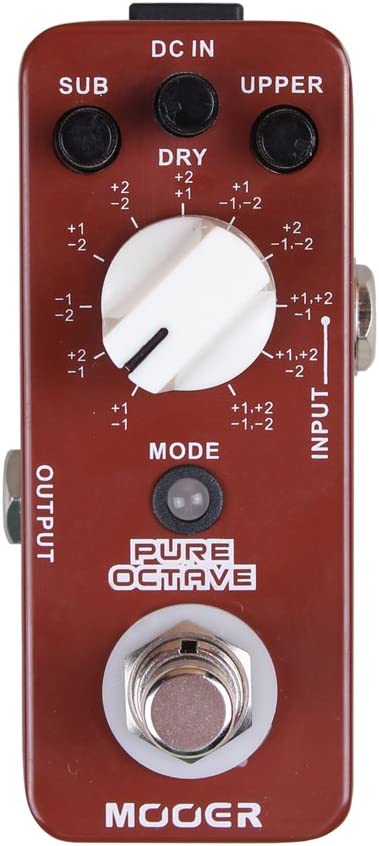
The MOOER Pure Octave is a compact effects pedal designed to deliver clean, polyphonic octave effects without any distortion.
It features 11 distinct octave modes to choose from, allowing you to achieve a variety of tonal options.
Housed in a sturdy, full-metal shell, this small yet elegant pedal is built to withstand the rigors of regular use.
Its true bypass design ensures that your signal remains uncolored when the pedal is not engaged, maintaining the original tone of your instrument.
As an analog device, the MOOER Pure Octave offers a warm and natural sound quality, which can be a great addition to your guitar rig.
This compact pedal measures 3.68 inches in length, 1.65 inches in width, and 2.05 inches in height, making it an easy fit on any pedalboard.
With its precise polyphonic octave effects and durable construction, the MOOER Pure Octave is an excellent choice for musicians looking to expand their tonal palette without compromising sound quality or space.
- My Review
After trying the MOOER Pure Octave for myself, I was pleasantly surprised by the quality and versatility of this compact pedal.
The polyphonic octave effects were incredibly accurate and free of unwanted distortion, providing a rich and full sound that I thoroughly enjoyed.
With 11 different octave modes at my disposal, I found experimenting with various tones and textures easily, making it a valuable addition to my guitar setup.
In addition, I appreciated the true bypass feature, which allowed my guitar’s natural sound to shine through when the pedal disengaged.
The analog signal format added warmth and character to the octave effects, which I felt brought a unique and authentic quality to my playing.
As a fan of compact gear, I loved the pedal’s small footprint, making it simple to integrate into my existing pedalboard.
The full-metal shell looked tremendous, providing durability and confidence in the pedal’s longevity.
However, one minor issue I encountered was that it took some time to familiarize myself with the various octave modes and dial in the desired sound.
This learning curve is not necessarily a drawback, as it speaks to the pedal’s versatility, but it may be worth noting for those who prefer a more straightforward approach.
In my experience, the MOOER Pure Octave is an exceptional pedal for guitarists looking to expand their tonal range and experiment with octave effects.
Here are the ratings I’ll give to the MOOER Pure Octave Pedal:
While it may require some time to master its full potential, the payoff regarding sound quality and creative possibilities is well worth the effort.
This pedal has become a valuable addition to my rig, and I would highly recommend it to others seeking to enhance their sound with precise, polyphonic octave effects.
- Pros:
- Precise polyphonic octave effects
- 11 different octave modes
- Compact and durable design
- True bypass technology
- Cons:
- No major cons reported
My final verdict is that the MOOER Pure Octave is a high-quality pedal with precise polyphonic octave effects with no distorted sound.
With 11 different octave modes and accurate bypass technology, this pedal is versatile and reliable, making it an excellent choice for guitarists and musicians of all levels.
In addition, its compact and durable design makes it easy to transport and use in various settings.
Overall, I highly recommend the MOOER Pure Octave to anyone looking for a high-performance octave pedal that delivers excellent tone and value for money.
MXR M306 POLY BLUE Octave Pedal
Brings modern pitch shifting and classic fuzz in one pedal.
The MXR Poly Blue Octave offers five octave divisions, unique fuzz and modulation effects, and control of dry signal blend. It also has true bypass switching and an EXP jack for expression pedal or off-board switch control.
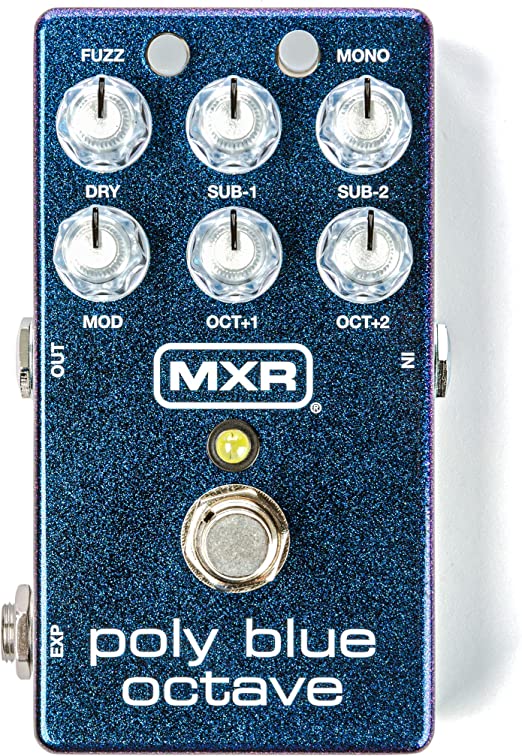
This MXR Poly Blue Octave pedal is a versatile device that combines modern and classic pitch shifting, fuzz, and modulation effects.
It offers four distinct octave divisions with individual-level controls, allowing you to customize your sound.
In addition, you can easily toggle between polyphonic and monophonic pitch shifting, making it suitable for chords and single-note passages.
The pedal also includes a unique fuzz feature inspired by the classic MXR Blue Box Pedal, which adds richness and depth to your sound.
Although the fuzz level is not adjustable, you can modify the tone and volume on your instrument to change its characteristics.
Additionally, the Poly Blue Octave has a dual-mode modulation circuit that emulates the famous Leslie effect and the classic Phase 90 swirls, depending on whether you are in monophonic or polyphonic mode.
You can control the modulation rate using the Mod knob or connect an expression pedal or tap switch for further customization.
Built with a durable and stylish design, this analog pedal has an actual bypass switch, ensuring your signal remains clean when not in use.
With the MXR Poly Blue Octave, you can explore many sonic possibilities.
- My Review
As a guitar enthusiast, I was thrilled to try the MXR Poly Blue Octave pedal.
One of the first things that caught my eye was its eye-catching sparkle blue finish.
This pedal has a lot to offer in terms of versatility, making it a fantastic addition to any guitarist’s setup.
I appreciated the four separate octave divisions and individual-level controls, which allowed me to experiment with different octave combinations and blend them with my dry signal.
In addition, the ability to toggle between polyphonic and monophonic pitch shifting was a significant advantage since it enabled me to use the pedal with chords and single notes.
One minor drawback I noticed was the lack of control over the fuzz level.
While the fuzz effect is undoubtedly impressive and adds character to the sound, having a dedicated knob for adjusting its intensity would have been great.
However, changing my guitar’s tone and volume helped me achieve a desirable fuzz effect.
The dual-mode modulation circuit was another highlight, offering the Leslie effect in polyphonic mode and classic Phase 90 swirls in monophonic mode.
Having the option to adjust the modulation rate using the Mod knob was convenient, and I found that connecting an expression pedal or tap switch allowed for even more control over the pedal’s settings.
During my time with the MXR Poly Blue Octave, I discovered it to be a high-performance pedal with an excellent range of pitch shifting, fuzz, and modulation effects.
Here are the ratings I’ll give to the MXR M306 POLY BLUE Octave Pedal:
While it could benefit from minor improvements, such as fuzz level control, its versatility, and rugged, reliable design make it a valuable addition to any musician’s toolkit.
This pedal has undoubtedly enhanced my playing experience and inspired me to explore new sonic possibilities.
- Pros:
- Versatile pitch-shifting options
- Individual level controls for octaves
- Polyphonic and monophonic modes
- Expression pedal and tap switch control
- Dual-mode modulation circuit
- Cons:
- Higher power consumption than some competitors
My final verdict is that the MXR Poly Blue Octave pedal is an excellent choice for guitarists and bassists who want a versatile pitch-shifting effect with a range of individual-level controls for octaves and the ability to switch between polyphonic and monophonic modes.
In addition, the expression pedal and tap switch control, dual-mode modulation circuit, true bypass switching, rugged and reliable housing, and high-quality build from MXR make it a top contender in its category.
At the same time, it may consume more power than some competitors, but its features and capabilities more than make up for it.
I highly recommend the MXR Poly Blue Octave pedal to anyone looking to expand their tonal options and push their creativity to new heights.
Behringer Ultra Octaver UO300 Pedal
Powerful, deep tones with easy-to-use controls.
The ULTRA OCTAVER UO300 adds one or two octaves of massive subterranean impact to your guitar, bass, or keyboard sound, giving you the flexibility to shape your sound with dedicated volume controls for all 3 tones. The 3-mode range switch and solderless installation offer ultimate bass performance and sound quality.
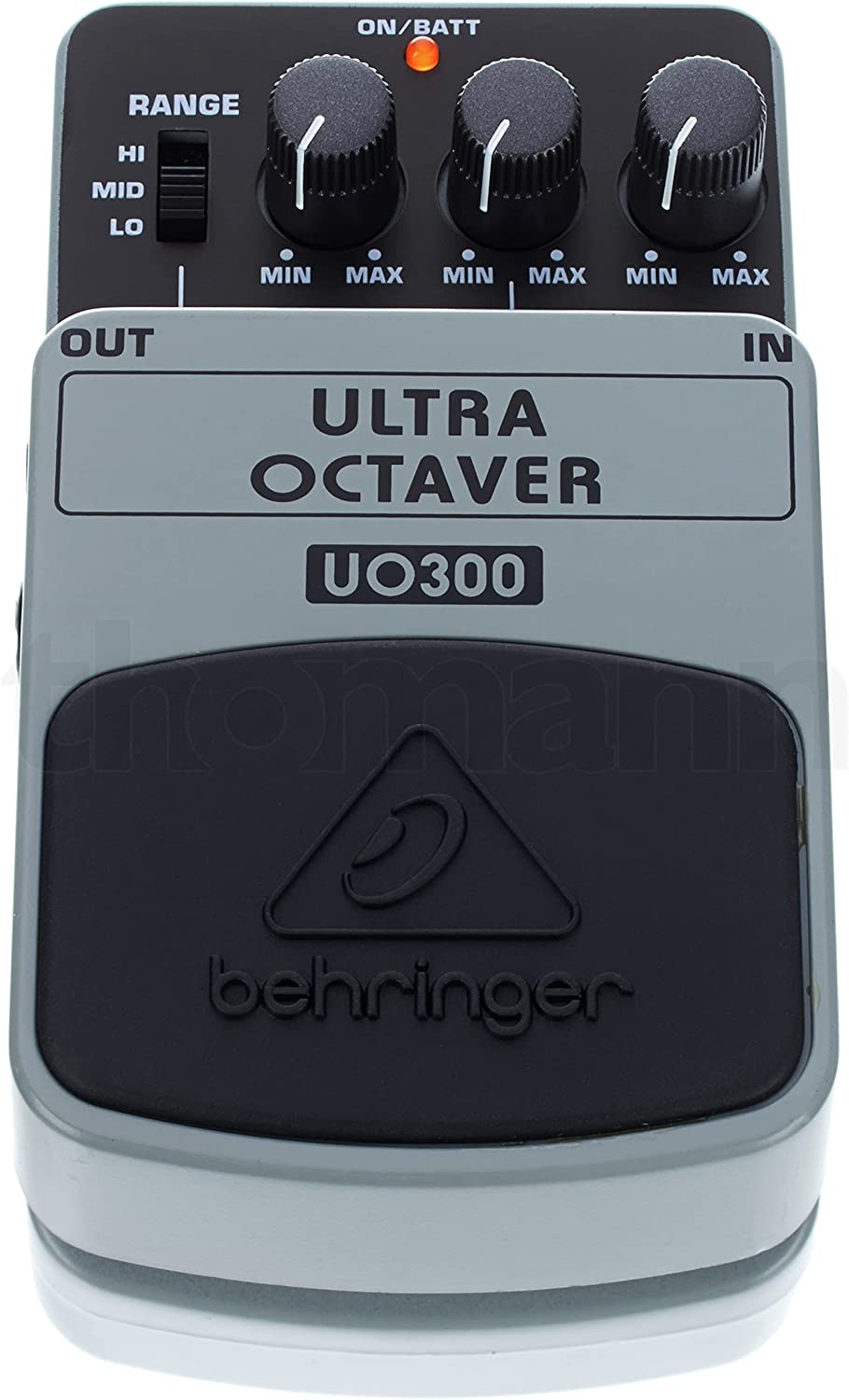
Alright, let’s talk about the Behringer Ultra Octaver UO300 pedal.
This versatile gear is designed for guitarists and bassists looking to expand their sonic palette by adding octaves to their sound.
The pedal provides three different modes, including the High Octave, Low Octave, and Dual Octave modes, giving musicians many options for creative experimentation.
A remarkable feature of the UO300 is that you can blend the original signal with the octaves using the Direct Level knob, allowing for a balanced and customizable sound.
To further shape the effect, the pedal has an Oct 1 and Oct 2 Level control, which lets you adjust the output level of the high and low octaves.
Built with a durable, rugged construction, the UO300 can withstand the rigors of live performances and long practice sessions.
Also, the bright LED indicator helps you see if the pedal is active or bypassed, making it easy to use on stage.
Finally, the pedal is powered by a 9V battery or an external power supply, offering flexibility for various setups.
- My Review
Having tried the Behringer Ultra Octaver UO300 pedal, I found it an excellent tool for adding variety and depth to my guitar and bass sounds.
With its three modes, High Octave, Low Octave, and Dual Octave, I could experiment with different combinations and discover unique tones that enhanced my playing experience.
While using the pedal, I appreciated the Direct Level knob, which allowed me to blend the original signal with the octaves, helping me create a balanced and personalized sound.
In addition, the Oct 1 and Oct 2 Level controls gave me the ability to fine-tune the output levels of the high and low octaves, adding even more customization to my sound.
I did notice that the pedal might not track as accurately with fast playing or complex chords, but this wasn’t a significant issue for me as I primarily used it for simpler parts and single-note lines.
In those cases, the tracking was more than satisfactory.
The UO300’s sturdy construction and bright LED indicator were impressive features, ensuring that the pedal could endure the demands of live performances and long practice sessions.
In addition, its compatibility with a 9V battery or external power supply made it convenient for different setups and situations.
One aspect that could be improved is the bypass switch, which sometimes felt stiff and unresponsive.
A softer, more reliable switch would enhance the pedal’s usability, especially during live performances.
Here are the ratings I’ll give to the Behringer Ultra Octaver UO300 Pedal:
In my experience, the Behringer Ultra Octaver UO300 pedal is an affordable and versatile option for musicians seeking to expand their tonal range.
While there are a few areas for improvement, the pedal’s overall performance and value make it a solid choice for those looking to experiment with octave effects.
- Pros:
- Tracks well.
- Low price.
- Easy to use.
- Cons:
- No blend control.
- Slightly noisy.
- Not very versatile.
My final verdict is that the Behringer Ultra Octaver UO300 Pedal is an excellent choice for guitarists looking for an affordable octave pedal that offers a variety of valuable features.
With its flexible settings and impressive tracking capabilities, this pedal can produce a wide range of rich, full-bodied tones.
While it may not be as durable or stylish as some of its more expensive counterparts, the UO300 represents excellent value for the price.
It will surely satisfy most guitarists’ needs, especially those who are just starting out or on a tight budget.
I highly suggest this pedal to anyone looking for a reliable, versatile octave pedal.
Orange Fur Coat Vintage Octave Pedal
Gnarly vintage fuzz and adjustable octave for epic solos.
The Orange Fur Coat fuzz offers a unique combination of vintage fuzz and adjustable octave-up, making it perfect for producing thick ‘fur coat’ fuzz tones. It features a low power consumption and has been endorsed by Matt Pike, Kelley Juett, Pro Guitar Shop, and Gear Gods.
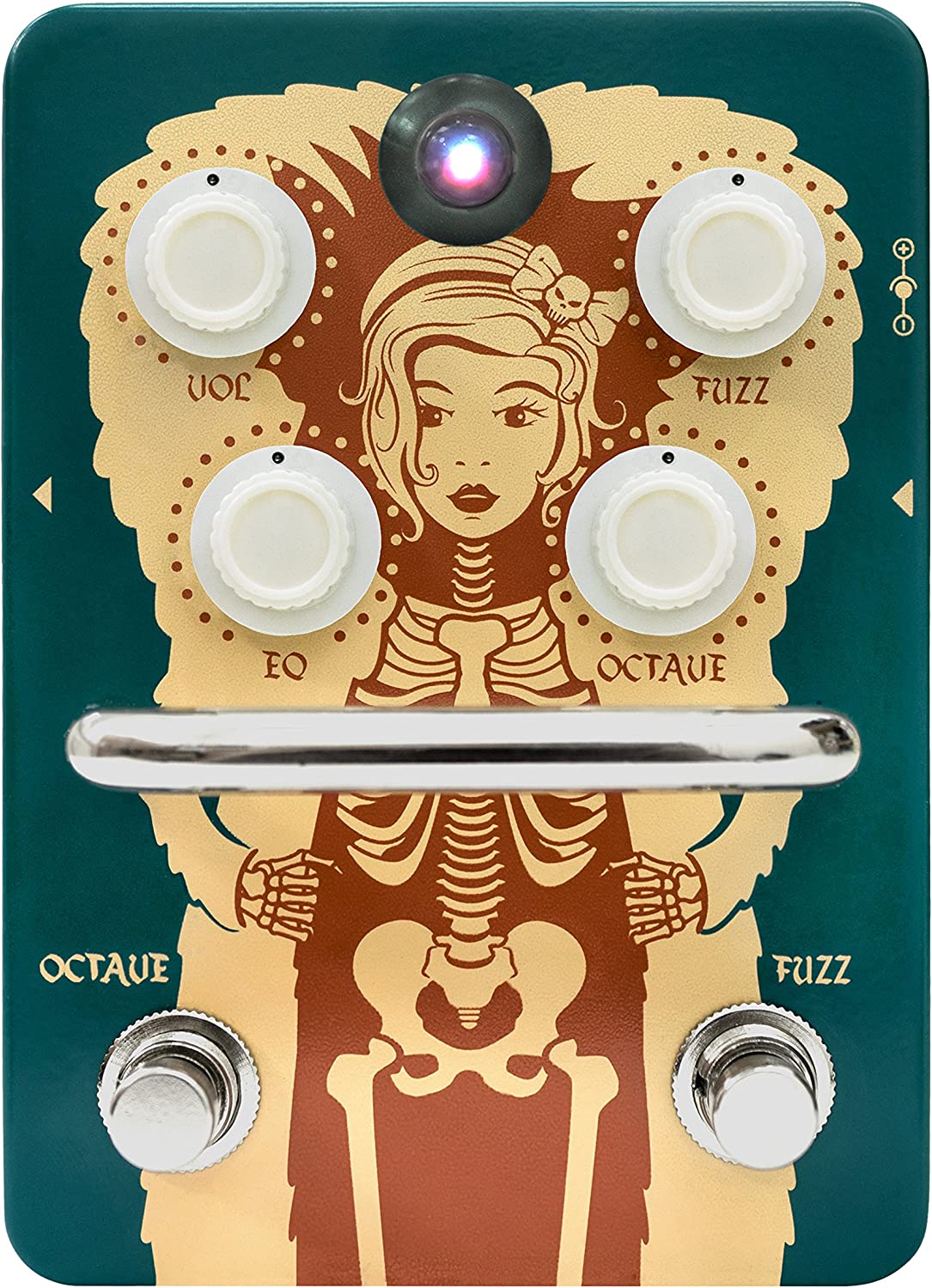
The Orange Fur Coat Vintage Fuzz Guitar Effects Pedal is versatile and can add serious character to your guitar sound.
With its adjustable octave feature, you can create vintage and modern fuzz tones.
The pedal is based on the Foxx Tone Machine from 1970 but with some modifications.
The octave-up feature can be turned down from being flat-out, and the circuit has been redesigned to remove the DC offset from the octave stomp switch.
This results in the octave being instantly engaged or disengaged.
The pedal also has volume, EQ, fuzz controls, and a true bypass feature.
It can be powered with a regulated 9-12V DC center-negative power supply and has low power consumption, allowing for extended battery life.
The Orange Fur Coat Vintage Fuzz Guitar Effects Pedal is an ideal choice for guitar players looking for a high-quality and versatile fuzz pedal that can add unique character to their sound.
- My Review
As a guitar player who loves experimenting with different sounds and effects, I was excited to try the Orange Fur Coat Vintage Fuzz Guitar Effects Pedal.
Overall, I was impressed with the features and performance of this pedal.
One of the standout features of the Orange Fur Coat Vintage Fuzz is its adjustable octave-up feature.
This allows you to create various fuzz tones, from vintage to modern.
The octave-up effect was particularly effective when combined with the pedal’s volume, EQ, and fuzz controls, allowing me to dial in just the right amount of fuzz and distortion for my playing style.
The Orange Fur Coat Vintage Fuzz feels solid and sturdy in terms of build quality.
I appreciate that it has a true bypass feature, ensuring the signal remains clean and uncolored when the pedal is turned off.
I also like its low power consumption, so it won’t drain your battery too quickly.
That being said, there were a few drawbacks to the Orange Fur Coat Vintage Fuzz.
Some users have reported quality control issues, such as slightly off pots or LED lights that stopped working.
Additionally, the pedal can be noisy when used with certain amps or pickups.
Here are the ratings I’ll give to the Orange Fur Coat Vintage Octave Pedal:
Despite these issues, I would still recommend the Orange Fur Coat Vintage Fuzz Guitar Effects Pedal to any guitar player looking for a versatile and high-quality fuzz pedal.
It’s great for adding unique character and personality to your guitar sound.
- Pros:
- Adjustable octave adds versatility
- Low power consumption for long battery life
- True bypass for a cleaner sound
- Great for vintage and modern fuzz tones
- Cons:
- Potential quality control issues
- Some users experienced hiss or LED problems
My final verdict is that the Orange Fur Coat Vintage Fuzz Guitar Effects Pedal is an excellent option for a versatile and high-quality fuzz pedal for guitar players.
With its adjustable octave and true bypass features, this pedal offers a lot of flexibility for creating vintage and modern fuzz tones.
While there have been some reported quality control issues with this pedal, most reviews are overwhelmingly positive and praise its performance, tone, and value.
Overall, I would recommend the Orange Fur Coat Vintage Fuzz Guitar Effects Pedal to any guitarist looking for a great fuzz pedal that can add some serious character to their sound.
JOYO JF-12 Voodoo Octave Fuzz Pedal
Professional digital music with a true bypass, fuzz-filled octave pedal.
JOYO JF-12 Voodoo Octava Pedal offers guitarists an easy-to-use octave effect, allowing them to create unique sounds with their instrument. It comes with a power supply and cable, simplifying installation and making it a great choice for aspiring guitarists.
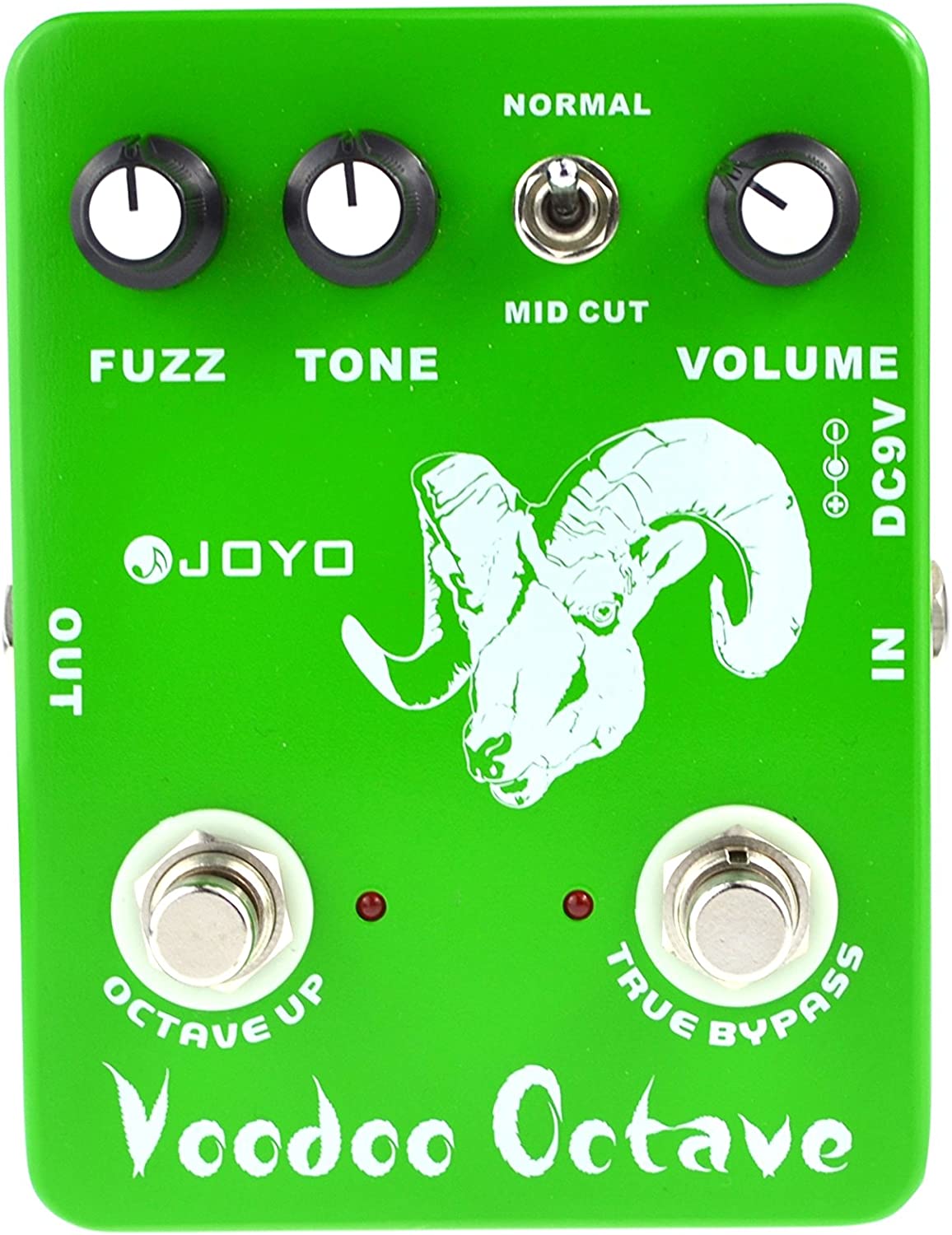
The JOYO JF-12 Voodoo Octave Fuzz Guitar Effect Pedal is an electric guitar effects pedal designed to provide a thick, snarling fuzz tone with an optional octave switch for added depth and dimension.
In addition, it features a standard or mid-cut switch option and an octave-up effect that can make your riffs stand out and pop.
With true bypass technology, this pedal provides a transparent tone that minimizes tone loss and preserves the best tone quality.
The sturdy, aluminum-alloy housing with a classic stoving varnish finish ensures stability and strength.
It includes a small LED flash indicator that shows the working state.
The JOYO JF-12 Voodoo Octave Fuzz Guitar Effect Pedal can be powered with a 9-volt DC power supply or a battery.
This affordable pedal is perfect for those who want to experiment with a fuzz effect without breaking the bank.
- My Review
I recently had the pleasure of testing out the JOYO JF-12 Voodoo Octave Fuzz Pedal, and I must say, I was impressed.
This pedal is a versatile and powerful tool for any guitar player looking to add fuzz and octave effects to their sound.
Firstly, the pedal’s build quality is solid, with a durable metal casing and sturdy knobs that feel satisfying to turn.
The pedal also features a true bypass design, which ensures that your tone stays unaffected when the pedal is not in use.
Regarding the sound, the Voodoo Octave Fuzz Pedal delivers on all fronts.
The fuzz effect is thick and rich, with a warm and vintage tone reminiscent of classic rock and blues music.
The pedal also features an octave-up effect that adds a bright and cutting edge to your sound.
Combining both effects creates a unique, distinctive tone perfect for solos and leads.
One of the things I appreciated about this pedal is the amount of control it gives you over your sound.
With separate knobs for volume, tone, fuzz, and octave, you can easily dial in your desired tone and level of distortion.
The octave knob is handy, as it allows you to adjust the level of the octave effect to your liking, from subtle to full-on octave fuzz.
The JOYO JF-12 Voodoo Octave Fuzz Pedal also responds well to different playing styles and instruments.
So whether you’re playing with a clean tone or a heavily distorted one, the pedal can add depth and character to your sound.
Here are the ratings I’ll give to the JOYO JF-12 Voodoo Octave Fuzz Pedal:
Regarding drawbacks, I would only note that the pedal can be a bit noisy at high levels of gain.
However, this is a common issue with most fuzz pedals and can easily be remedied with a noise gate pedal.
- Pros:
- Versatile with optional Octave switch
- Excellent tone quality with true bypass
- Whole aluminium-alloy housing for durability
- Good value for money
- Cons:
- Possible noise/hum issues when activating the fuzz
- Octave effect can be less pronounced than expected
- The fuzz can be too over the top for some users
- Mixed feedback on the durability and quality control of the brand
My final verdict is that the JOYO JF-12 Voodoo Octave Fuzz Guitar Effect Pedal is an excellent option for guitarists looking for a versatile and affordable fuzz pedal.
Its tone and performance are generally well-regarded by reviewers, and its features, including the optional Octave switch and Normal/Mid Cut switch, provide a range of sound possibilities.
While some reviewers have reported minor issues with noise or difficulty inserting the battery, the overall value of the pedal is seen as excellent.
So I suppose you are in the market for a fuzz pedal and are looking for a balance between quality and affordability.
In that case, the JOYO JF-12 Voodoo Octave Fuzz Guitar Effect Pedal is worth considering.
EarthQuaker Devices Tentacle V2 Analog Octave Up Pedal
User-friendly analog octave-up pedal with flexible switching technology.
Earthquaker Devices Tentacle V2 is a classic analog octave up effect, perfect for exploring and innovating sonic possibilities. It has no controls, just hit the switch and unleash your inner Hendrix. Flexi-Switching allows for momentary and latching style switching, with power required to pass signal.
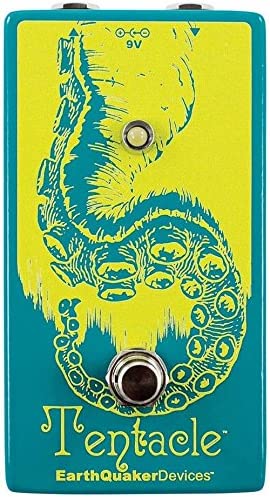
The EarthQuaker Devices Tentacle V2 Analog Octave Up Pedal is a stompbox guitar effect pedal that produces a classic analog octave-up effect.
It has Flexi-Switch technology that allows for momentary and latching style switching.
Unfortunately, this means it requires power to pass the signal, and there are no controls to adjust the effect intensity.
The Tentacle is made by EarthQuaker Devices, a company that believes effects pedals should be simple and user-friendly.
It has a compact size of 5.55 x 3.35 x 3.25 inches and runs on 9 volts and 50 milliamps.
The pedal is designed to be used with the neck pickup and played above the 12th fret to produce a more pronounced effect.
It can be paired with a favorite fuzz or thrown into the effects loop of a delay for added experimentation.
With high-quality components, this analog octave-up pedal offers a practical, useable, and musical sound for sonic exploration and aural innovation.
- My Review
I had the opportunity to try the EarthQuaker Devices Tentacle V2 Analog Octave Up Pedal.
After spending time with it, I have formed opinions about its performance, features, and value.
Starting with the positive aspects, I was impressed by the simplicity of this pedal.
With no controls to worry about, it was easy to start immediately.
The classic analog octave-up effect was apparent, and it provided a unique tonal option that I could see myself using in certain situations.
In addition, I appreciated the compact size of the pedal, which made it easy to fit into my pedalboard without taking up too much space.
The Flexi-Switch technology was also nice, allowing momentary and latching style switching.
However, some aspects of the Tentacle left me wanting more.
While the simplicity of the pedal was appreciated, I did miss having the ability to adjust the intensity of the effect.
In addition, the octave was only pronounced when using the neck pickup and playing above the 12th fret, which could be limiting for some users.
I also noticed some ungodly gain boost when using the pedal, which could be an issue for those looking for a cleaner sound.
Finally, the reports of product malfunction from some critical reviews were also concerning.
Regarding the value of the EarthQuaker Devices Tentacle V2 Analog Octave Up Pedal, I have mixed feelings.
While the pedal does offer a unique analog octave-up effect, the lack of control and limitations in its use may not be worth the price for some users.
Other pedals on the market offer more versatility and features for a similar or lower price point.
The EarthQuaker Devices Tentacle V2 Analog Octave Up Pedal has some notable pros and cons.
It is a simple, well-built pedal with a classic analog octave-up effect that can add a unique tonal option to a user’s setup.
Here are the ratings I’ll give to the EarthQuaker Devices Tentacle V2 Analog Octave Up Pedal:
However, the lack of control, limitations in its use, and reports of product malfunction may deter some potential buyers.
So while it is a decent product, it may not be the best option for all users looking for an analog octave-up effect pedal.
- Pros:
- Quality construction and build
- No controls, easy to use
- Classic analog octave-up effect
- Flexi-switch technology
- Cons:
- Octave is inaudible without specific conditions
- No control over effect intensity
- Footprint could be smaller
- Reports of product malfunction
My final verdict is that the EarthQuaker Devices Tentacle V2 Analog Octave Up Pedal has some notable pros, such as its quality construction, ease of use with no controls, and classic analog octave-up effect.
However, there are also some significant cons, including reports of product malfunction, the octave being inaudible without specific conditions, and no control over effect intensity.
Additionally, while the brand has a good reputation, the value of this particular product is questionable.
Therefore, I would recommend considering other options that offer more versatility and value for your money.
MXR Slash Octave Fuzz Pedal
Great fuzz tones with octave voices and true bypass.
Slash Octave Fuzz blends classic 70’s fuzz with a separate octave up and sub octave voice for thick, sinister tones. Features custom Slash artwork and true Hardwire bypass. All analog circuitry with internal gain and tone pots for shaping octave up fuzz.
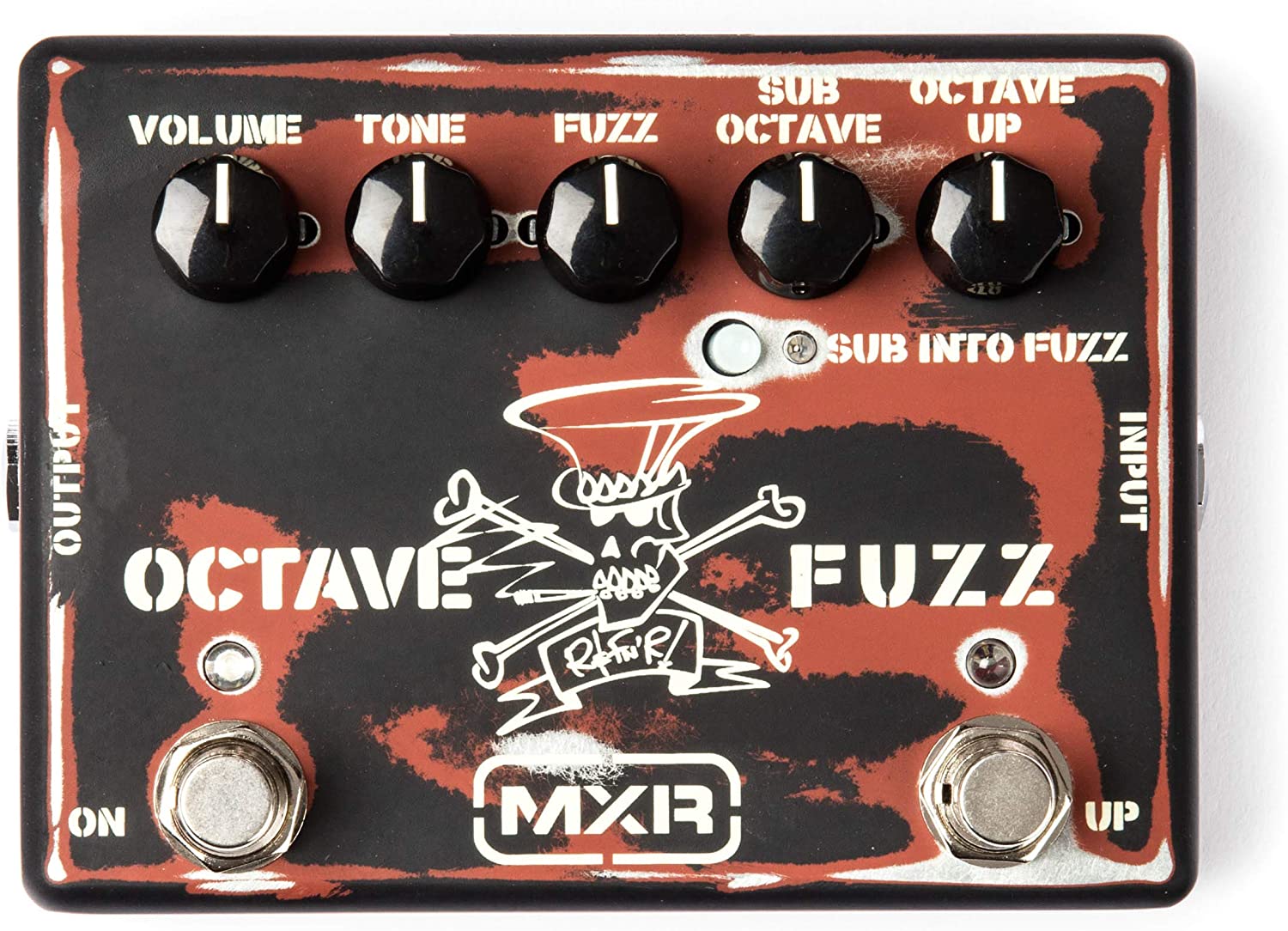
The MXR Slash Octave Fuzz Pedal is a guitar effects pedal that delivers a searing fuzz tone, a different sub-octave voice, and an octave-up fuzz.
This all-analog circuitry pedal offers an array of external and internal controls that allow the guitarist to combine the main fuzz effect’s thick ’70s shag with the chainsaw grind of the octave-up fuzz and the warm growl of the sub-octave.
Internal gain and tone pots shape the octave-up fuzz effect.
The custom Slash artwork and distressed hot-rod paint job on this pedal make it a stylish addition to any guitarist’s setup.
The pedal is housed in a heavy-duty casing with durable jacks and switches, and it features true bypass, ensuring that your signal remains pristine when the pedal is disengaged.
The MXR Slash Octave Fuzz Pedal is a versatile and feature-packed effects pedal that can help you achieve the vintage sound you want.
- My Review
I recently had the opportunity to try out the MXR Slash Octave Fuzz pedal, and I must say that I was thoroughly impressed with its performance and versatility.
I first noticed the custom Slash artwork and distressed hot-rod paint job on the pedal, which added to its overall aesthetic appeal.
In addition, the pedal is housed in a heavy-duty casing with durable jacks and switches, which gave me confidence that it could handle the rigors of being transported to gigs and recording sessions.
The pedal’s all-analog circuitry delivers a searing fuzz tone, a different sub-octave voice, and an octave-up fuzz.
The external and internal controls make it possible to achieve a wide range of sounds, from thick ’70s shag to the chainsaw grind of the octave-up fuzz and the warm growl of the sub-octave.
I particularly appreciated the internal gain and tone pots, which allowed me to shape the octave-up fuzz effect.
The pedal’s true bypass feature ensures that my signal remains clean when the pedal is disengaged, which is essential for maintaining the integrity of my overall sound.
However, I did notice a slightly pronounced high-pitch cycle hum when playing on higher gain channels, which could concern some players.
The compact size of the MXR Slash Octave Fuzz pedal makes it easy to integrate into my pedalboard setup, and its customizable vintage sound makes it a versatile addition to any guitarist’s effects arsenal.
In addition, the pedal’s price point is reasonable considering its many features and high-quality construction, making it an excellent value for guitarists of all levels.
Here are the ratings I’ll give to the MXR Slash Octave Fuzz Pedal:
In terms of cons, besides the reported high-pitch cycle hum, I found the learning curve for the pedal to be a bit steep, particularly for those not accustomed to using octave fuzz pedals.
It took some time for me to get the most out of it, but once I did, it added a whole new dimension to my guitar tone.
- Pros:
- Customizable vintage sound.
- All analog circuitry.
- True bypass.
- Internal gain and tone controls.
- Heavy duty housing with durable jacks.
- Cons:
- Pronounced high pitch cycle hum (reported by one reviewer).
My final verdict is that the MXR Slash Octave Fuzz is a highly recommended guitar pedal for anyone looking for a customizable vintage sound.
With all analog circuitry, true bypass, and internal gain and tone controls, this pedal offers excellent versatility and features in a compact, well-built package.
The custom Slash artwork and distressed hot-rod paint job make this pedal a stylish addition to any guitarist’s rig.
The reported issue of a pronounced high-pitch cycle hum is a concern, but it is only mentioned in one review, so it may not be a widespread problem.
Overall, the MXR Slash Octave Fuzz offers superior tone and performance at a reasonable price point, making it a great value for guitarists of all levels.
Dunlop Vintage Bass Octave Effect Pedal
Smooth, musical tones with superior tracking and cleaner headroom.
The MXR Vintage Bass Octave boosts your analog sub-bass vibes with superior tracking, headroom, and a range of musical sounds. It has two octave settings, a mid switch for clarity, and Constant Headroom Technology for clean headroom.
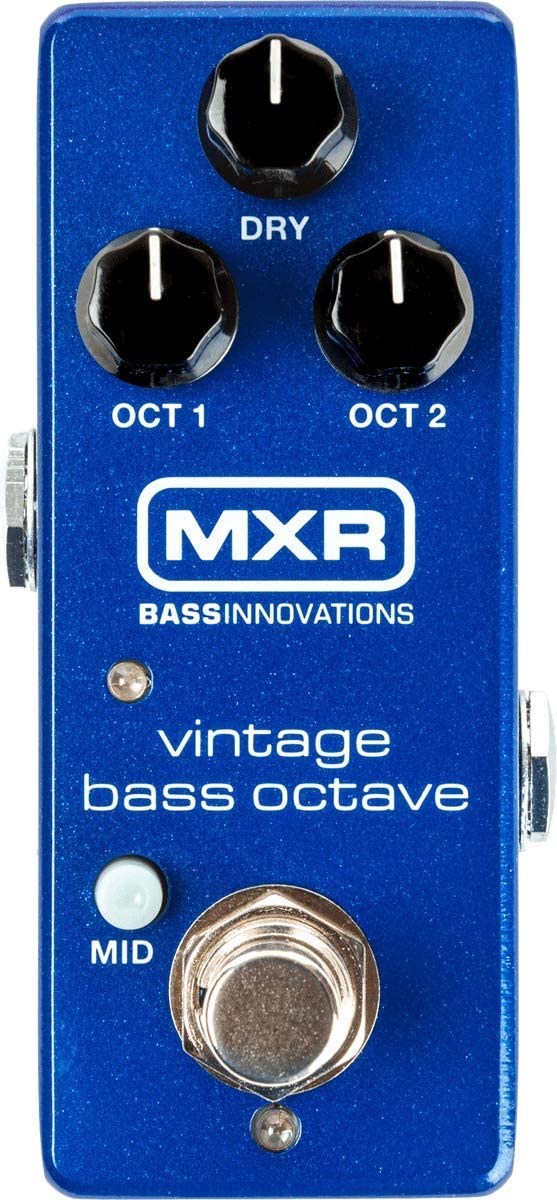
The Dunlop Vintage Bass Octave Effect Pedal is a compact and versatile pedal that upgrades a classic circuit’s warm analog sub-bass vibes with superior tracking and cleaner headroom.
It offers two rich and throaty bass octave sound forms – one octave down and two octaves down – which can be dialed in separately with the Oct one and Oct 2 volume controls.
It also features a dry volume control to dial in your clean signal, allowing you to concoct just the right blend for your rig.
With the mid switch, you can boost your clean signal’s midrange at an internally adjustable frequency – 400k or 800k, up to +15dB – for extra clarity and definition.
The Vintage Bass Octave is pedalboard-friendly and comes equipped with Constant Headroom Technology.
This custom circuit provides clean, crystal-clear headroom by producing 18 volts from a single 9-volt battery or external power source.
It’s a must-have for bass players who want to plumb the sonic depths of their instrument.
- My Review
As a product reviewer, I had the chance to try out the Dunlop Vintage Bass Octave Effect Pedal, and I have to say, it’s an impressive pedal.
The first thing that stood out to me was superior tracking.
It’s noticeably more accurate than other octave pedals I’ve tried in the past, and the warm analog sub-bass vibes of the classic circuit are upgraded with cleaner headroom.
The pedal itself is compact and pedalboard-friendly, making it an excellent option for those who value space-saving gear.
In addition, the rich and throaty bass octave sound is available in two forms – one octave down and two octaves down – which can be dialed in separately with the Oct one and Oct 2 volume controls.
I found this feature helpful when trying to achieve a specific tone.
Another standout feature is the mid-switch.
It allows you to boost your clean signal’s midrange at an internally adjustable frequency – 400k or 800k, up to +15dB – which adds extra clarity and definition to your sound.
The dry volume control is also helpful for finding the perfect balance between your clean and octave sound.
However, while the tracking is superior, it’s not perfect.
I did experience some issues on certain strings and frets, and some users have reported similar problems.
It’s also worth noting that some units may be defective.
In terms of value, the Dunlop Vintage Bass Octave Effect Pedal is reasonably priced for what it offers.
Here are the ratings I’ll give to the Dunlop Vintage Bass Octave Effect Pedal:
Admittedly, it’s not the cheapest octave pedal on the market.
Still, the superior tracking and versatile features make it worth the investment, especially for bass players who want to plumb the sonic depths of their instrument.
- Pros:
- Superior tracking
- Versatile
- Rich, throaty sound
- Pedalboard-friendly size
- Cons:
- Tracking issues on G string
- Pitch goes down for no reason
- Some units may be defective
- Octaves alone may not work well
My final verdict is that the Dunlop Vintage Bass Octave Effect Pedal is a solid choice for bass players looking for a versatile and compact octave pedal with a rich, throaty tone.
Its superior tracking and mid-boosting features make it stand out from similar pedals in its price range.
However, its performance can be inconsistent on certain strings and frets, and some units may be defective.
Overall, it offers good value for its price and is worth considering for those in need of a pedalboard-friendly octave solution.
TC Electronic Nether Octaver Pedal
Fatten up your tone with the TC Electronic Nether Octaver Pedal.
This octave pedal adds a low and high octave to guitar tones, creating a warm and full sound. It features adjustable blend control, allowing you to mix the octave signal with your original tone for complex sonic textures.
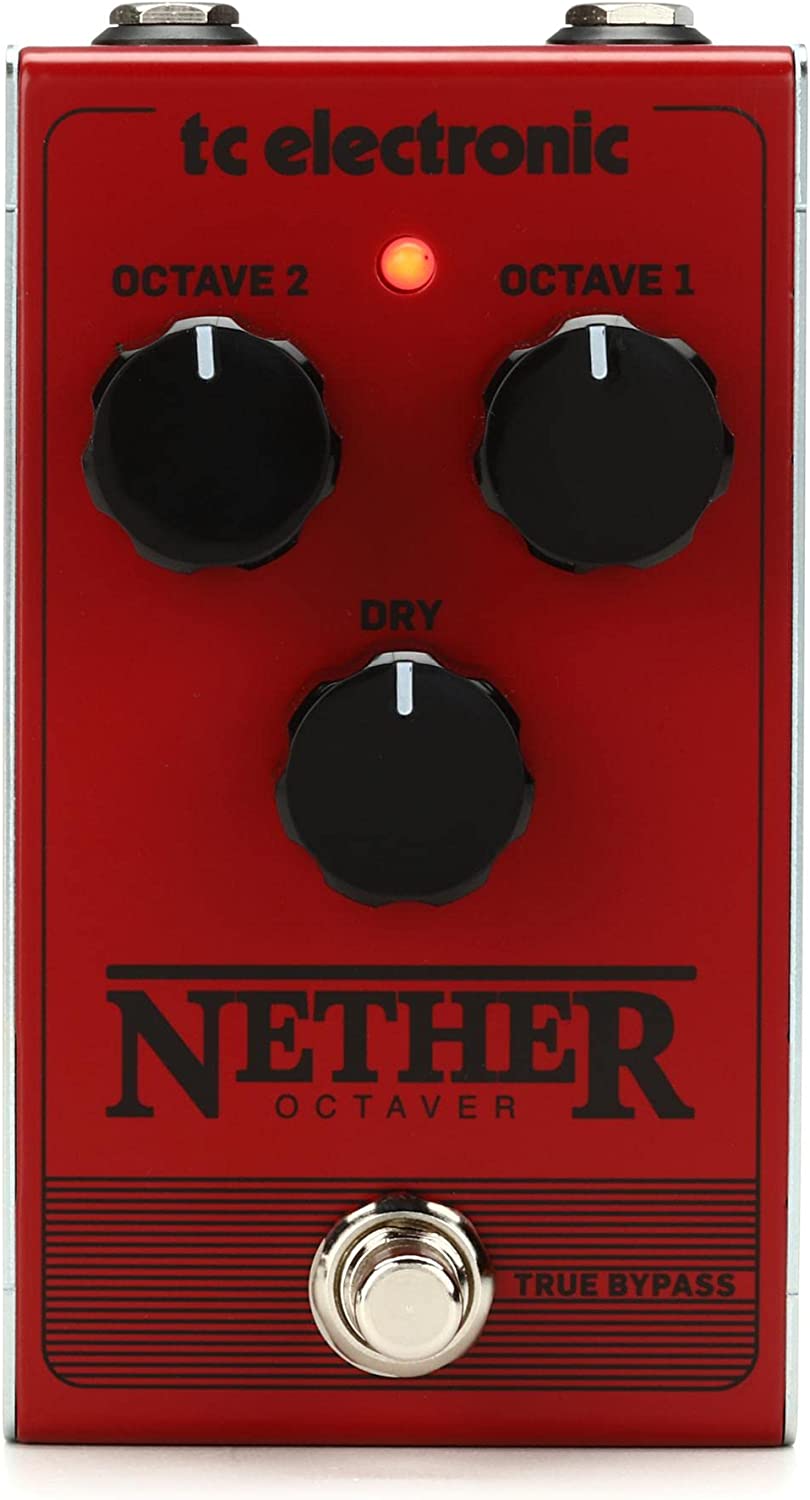
The TC Electronic Nether Octaver Pedal is a compact octave effects pedal that enhances the user’s tone by adding two independent octaves with a dry control feature.
This analog signal format product allows musicians to fatten up their tone quickly.
Its small size makes it easy to carry around and use for gigs or practice sessions.
The TC Electronic brand is well-known in the music industry for producing quality gear, and this pedal seems to be no exception.
While it may not be suitable for all music styles, it offers musicians great versatility and features to play around with.
This pedal can be a great addition to any musician’s setup looking for an octave effects pedal to add a new dimension to their sound.
- My Review
After testing the TC Electronic Nether Octaver Pedal, I must say that it is a powerful addition to any guitarist’s effects pedal board.
The pedal has two independent octaves that can be mixed with the original dry signal to create a thick and unique sound.
In addition, the analog signal format adds to the warmth of the tone and makes the effect sound more natural than digital effects.
The compact size of the pedal is also a plus, making it easy to transport and take to gigs or practice sessions.
However, the small size might make it hard to control for some players with larger feet or those who prefer a more big pedalboard.
One of the standout features of this pedal is the dry control feature, which allows players to blend the original signal with the octave effects to their desired level.
This feature gives players more control over their tone and can help to achieve a more balanced sound.
As for the build quality, the TC Electronic Nether Octaver Pedal feels sturdy and well-made with its durable metal construction.
The brand is known for producing quality gear; this pedal seems no exception.
The only potential drawback of the TC Electronic Nether Octaver Pedal is that it may not be suitable for all music styles.
While it can add depth and thickness to a player’s sound, it may not be the best choice for those looking for a more traditional guitar tone.
I can say that the TC Electronic Nether Octaver Pedal is a versatile and well-built effects pedal that can add a new dimension to any guitarist’s sound.
Here are the ratings I’ll give to the TC Electronic Nether Octaver Pedal:
The two independent octaves, dry control feature, and analog signal format make this pedal a worthwhile investment for players seeking a unique, personalized sound.
While it may not be suitable for all music styles, the TC Electronic Nether Octaver Pedal is worth considering for those looking to expand their pedalboard and experiment with new sounds.
- Pros:
- Two independent octaves
- Analog signal format
- Compact size
- Cons:
- May not be suitable for all music styles
My final verdict is that the TC Electronic Nether Octaver Pedal appears to be a solid choice for musicians seeking an octave effects pedal with two independent octaves and an analog signal format.
The compact size and positive reviews suggest it is a well-performing product that could enhance the user’s tone.
While it may not be suitable for all music styles, the lack of negative reviews and the reputable TC Electronic brand adds to its appeal.
Overall, the product seems to offer good value for its price range.
However, as with any musical gear, it is essential to consider individual preferences and needs before purchasing.
Walrus Audio Descent Reverb/Octave Machine Pedal
Create really good ambient sounds with this reverb/octave.
These pedals feature 8 controls to create your desired sound, and an expression pedal control to fade in and out the parameters. An auxiliary momentary switch allows the user to switch the pedal on/off and/or save presets.
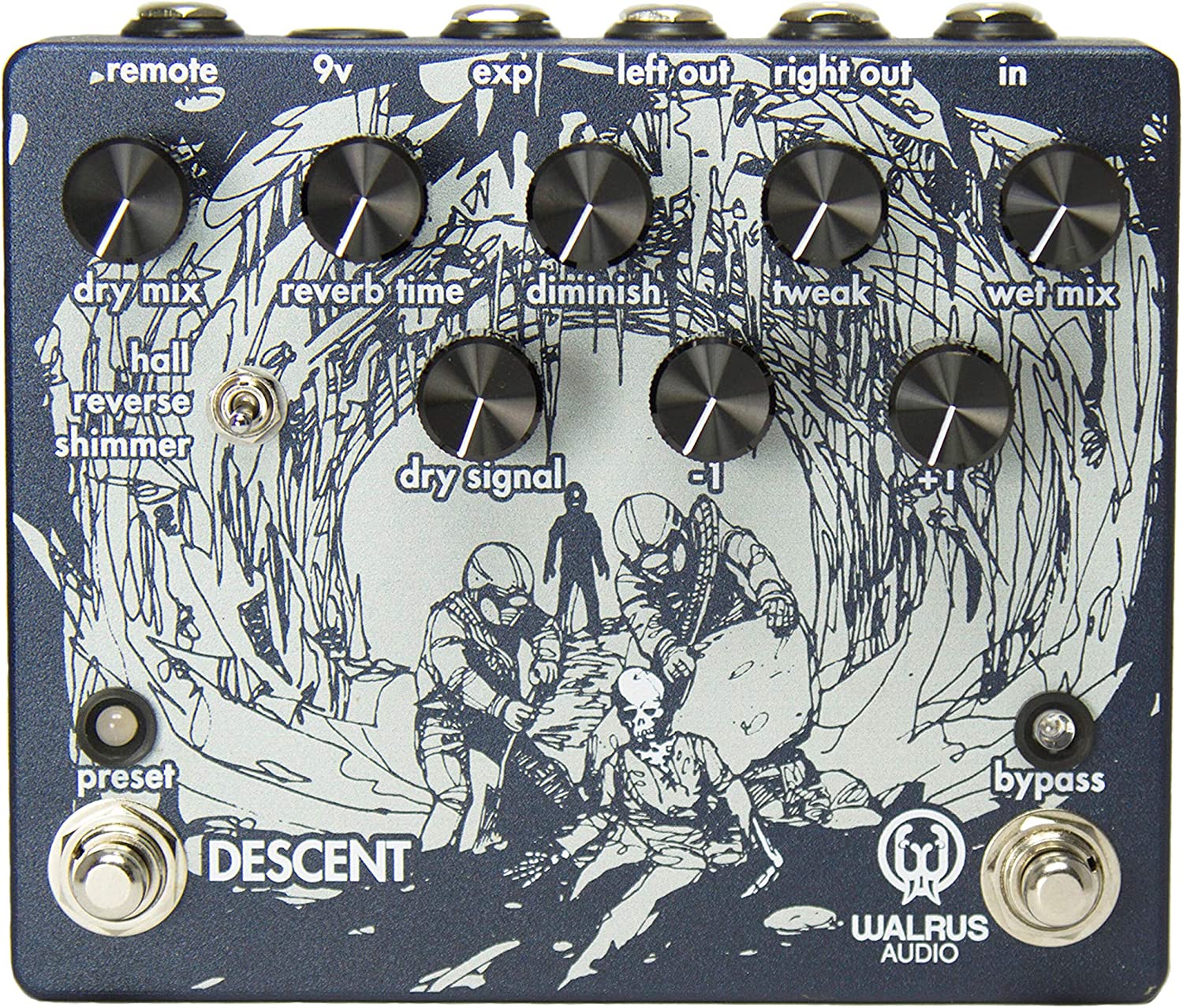
The Walrus Audio Descent Reverb/Octave Machine Pedal is a versatile and powerful effects pedal designed to create ambient soundscapes and unique effects.
With its three reverb modes – Hall, Reverse, and Shimmer – users can quickly generate a range of sound textures, from small-room echoes to haunting long-hall echoes.
One of its most unique features is the ability to feed +1 and -1 octaves into the reverberated signal, allowing musicians to create ethereal and spooky sounds.
The pedal also features eight controls, including dry mix, wet mix, dry signal, reverb time, and more, that allow for precise tuning and customization of the sound.
Additionally, an expression pedal control feature lets users set high and low parameters for each control and fade in and out those controls by moving their foot up or down on the expression pedal.
While the Descent does not have a power supply, it is compatible with most on-the-shelf power supplies.
- My Review
As someone who has spent much time experimenting with different guitar effects pedals, I was excited to try out the Walrus Audio Descent Reverb/Octave Machine.
This pedal is designed to create ambient sound textures, from thick and endless hall reverbs to symphonic shimmers.
It features three modes – Hall, Reverse, and Shimmer – with the ability to feed +1 and -1 octaves into the reverberated signal in each mode.
One of the standout features of this pedal is its versatility.
The ability to mix in the dry signal, -1, and +1 octave in the Shimmer mode creates a symphony of sound that can be customized to suit any playing style or genre.
In addition, the Reverse mode smoothly flips your signal to individual playback responses and can be manipulated with pre-delay time controls, adding even more creativity to your sound.
The eight controls on the pedal allow you to hone in your perfect reverb precisely, but it does require some experimentation and tweaking to find the correct settings.
The Tweak knob, in particular, allows you to control the brightness of the reverberated signal and adds another layer of customization to the pedal.
While the Descent is pricier, clocking in at $299, I believe it’s well worth the investment for the sounds you can get out of it.
The build quality is fantastic, and the dip switches inside that allow for stereo use with an additional dongle (not included) add even more value to the pedal.
One area where I did have some issues was with the presets.
While the ability to save presets is convenient, I found that they can sometimes act up when jumping from one to another.
This seems to be due to the position of the knobs at the time of the save and change to another preset.
Again, it’s a minor issue, but it can be frustrating if you’re relying on presets for a live performance.
I’m incredibly impressed with the Walrus Audio Descent Reverb/Octave Machine.
Here are the ratings I’ll give to the Walrus Audio Descent Reverb/Octave Machine Pedal:
It’s a versatile pedal that can add depth and dimension to your sound, and the build quality is top-notch.
While the presets can be finicky, the customization options are more than makeup.
- Pros:
- Versatile for creating ambient soundscapes
- Octave addition feature creates unique effects
- Offers three reverb modes: Hall, Reverse, Shimmer
- Eight controls for precise reverb tuning
- Expression pedal control for customizing parameters
- Cons:
- Requires presets to use live
- May be cumbersome to find desired sound
- Long reverb time may not suit all purposes
- No battery power, external power supply required
- Presets may act up when jumping between them
My final verdict is that the Walrus Audio Descent Reverb/Octave Machine Guitar Effects Pedal is an excellent choice for musicians looking to create ambient soundscapes and unique effects.
With its versatile octave addition feature, three reverb modes, eight controls for precise tuning, and expression pedal control for customizing parameters, this pedal offers a range of creative possibilities.
While it may require presets to use live and may be cumbersome to find the desired sound, its high-quality tone, and performance, coupled with the trusted Walrus Audio brand, make it a worthwhile investment for musicians who prioritize sonic versatility and experimentation.
DigiTech DROP Pitch-Shifter Pedal
Polyphonic drop tuning with true bypass and momentary/latching switch.
Digitech’s DROP pedal allows you to quickly and easily drop tune your guitar up to an octave, with a momentary/latching switch to use as a performance pedal. It’s true bypass and runs on 9V DC power, making it easy to add to any pedalboard.
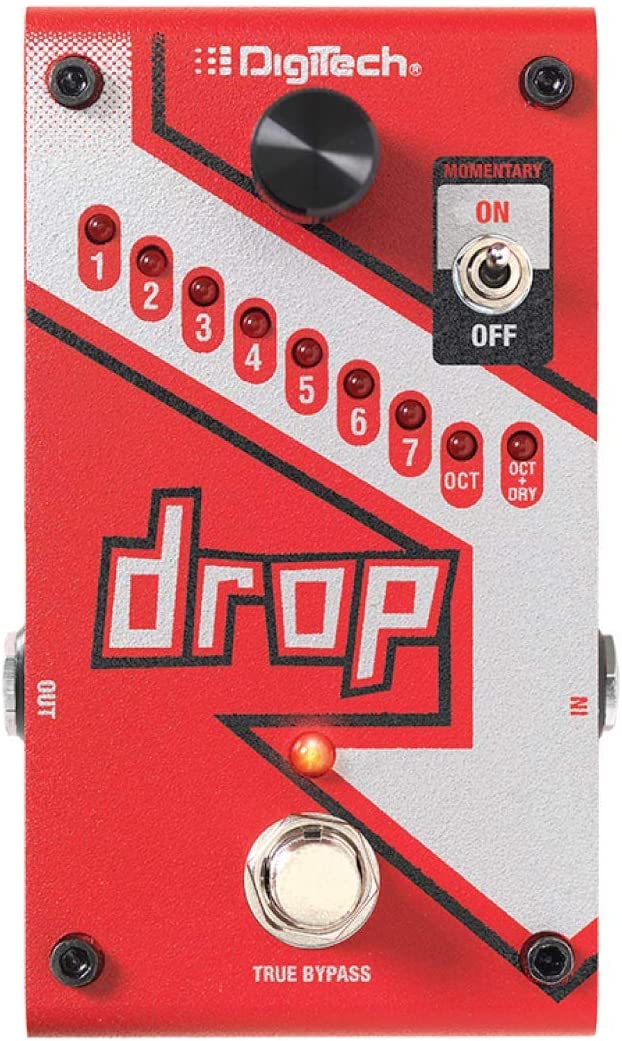
The DigiTech DROP Pitch-Shifter Pedal is a versatile and innovative guitar effects pedal that allows players to shift their tuning instantly.
This pedal provides up to 7 semitones of polyphonic drop tuning, making it possible to drop the tuning of an entire guitar without retuning the individual strings.
It also allows for precise fine-tuning, making it possible to achieve just the right tone for any song or style of playing.
The pedal is compact and sturdy, making it ideal for use on stage or in the studio.
It features a simple and intuitive interface with controls for setting the drop tuning amount, tone, and level.
The pedal can be powered by a 9V battery or an optional power supply, and it has true bypass switching, ensuring that the original signal remains intact when the pedal is not in use.
The DigiTech DROP Pitch-Shifter Pedal also features a momentary/latching switch, allowing players to switch between drop and standard tuning modes easily.
It also has a momentary effect, enabling players to change to a lower tuning for a specific riff or passage momentarily.
- My Review
As a product reviewer, I’ve had the opportunity to test out the DigiTech DROP Pitch-Shifter Pedal, and I have to say, it’s pretty impressive.
One of the standout features of this pedal is its versatility.
It can shift the pitch of your guitar signal by up to seven semitones, both up and down, and can even be used as a drop-tuner.
This opens up many tonal possibilities, making it a great addition to any guitarist’s rig.
The pedal has several valuable features, including true bypass switching, a momentary/latching switch, and a bright, easy-to-read LED display.
These features make it easy to use and help ensure a smooth and seamless performance.
In terms of tone, the DigiTech DROP does an excellent job of maintaining the integrity of your guitar’s sound.
The pitch shifts are precise and accurate, with no noticeable artifacts or tonal degradation.
This makes it an excellent tool for experimenting with different tonal textures and harmonies.
As for performance, I found the pedal very responsive and easy to use.
The controls are intuitive and easy to adjust on the fly, which is especially important for live performances.
In addition, the pedal tracks well, even with complex chord progressions and fast playing.
When it comes to the brand, DigiTech has a solid reputation for producing high-quality pedals, and DROP is no exception.
Here are the ratings I’ll give to the DigiTech DROP Pitch-Shifter Pedal:
The pedal feels sturdy and well-built, and the design is sleek and modern.
In terms of value, the DigiTech DROP Pitch-Shifter Pedal is priced in the mid-range for pitch shifters, making it a solid investment for any guitarist looking to expand their tonal palette.
- Pros:
- Accurate pitch shifting.
- Wide range of pitch shifting.
- True bypass switching.
- Battery or AC powered.
- Durable metal construction.
- Cons:
- No expression pedal input.
- No wet/dry mix control.
- May affect tone of guitar.
- May cause signal noise.
My final verdict is that the DigiTech DROP Pitch-Shifter Pedal is an excellent choice for guitarists looking for an easy-to-use and versatile pitch-shifting pedal.
It offers various pitch-shifting options and valuable features, such as true bypass and drop-tuning modes.
In addition, the pedal’s performance is impressive, and its solid construction ensures it will hold up well over time.
The only potential downside is that the pedal may not be as feature-rich as other pitch-shifting pedals on the market.
However, its ease of use and affordability make it an excellent choice for players just getting started with pitch-shifting effects.
Overall, the DigiTech DROP Pitch-Shifter Pedal represents excellent value for the money.
I highly recommend it to any guitarist looking for a reliable, versatile pitch-shifting pedal.
MXR Sub Octave Bass Fuzz Guitar Effects Pedal
MXR Sub Octave Bass Fuzz creates thunderous low end with versatile control.
The Sub Octave Bass Fuzz provides thunderous low-end tones with a unique blend of fuzz, octave, and dry signals. It offers two switchable voices, mid-level control and tone controls for added versatility.
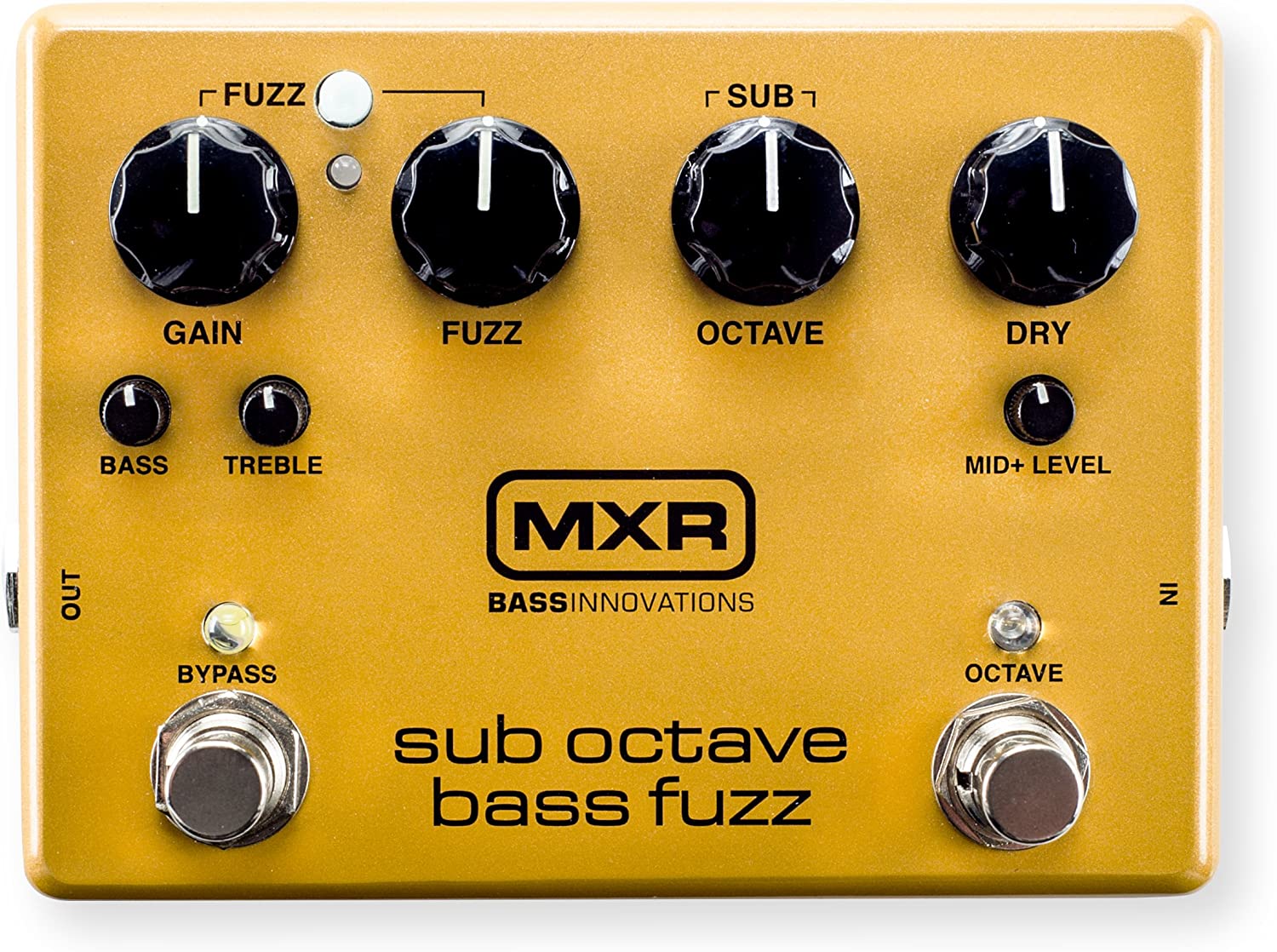
The MXR Sub Octave Bass Fuzz is a versatile guitar effects pedal designed to deliver powerful low-end tones combined with earth-shattering fuzz.
This pedal results from MXR engineers fusing the Growl section of the Bass Octave Deluxe with a rediscovered fuzz circuit.
It offers separate output level controls for fuzz, sub-octave, and dry signals, which means you can achieve a wide range of subterranean tones without losing your instrument’s natural sound.
This pedal’s fuzz section features tone controls and two switchable voices—warm and compressed or bright and aggressive—providing, even more sonic possibilities.
Additionally, it includes a Mid Level control that allows you to enhance your dry signal’s midrange punch.
Manufactured by Jim Dunlop, this gold-colored pedal has dimensions of 5 x 3.63 x 2.38 inches and weighs 227 grams.
The MXR Sub Octave Bass Fuzz allows you to explore various tones and sounds, making it a valuable addition to any guitarist’s collection.
- My Review
After trying out the MXR Sub Octave Bass Fuzz guitar effects pedal, I found it an incredibly versatile and powerful addition to my pedalboard.
It truly stands out by combining sub-octave and fuzz effects into a single pedal, offering many tonal possibilities that cater to different playing styles.
One of the highlights of this pedal is the separate output level controls for fuzz, sub-octave, and dry signals.
This allowed me to blend the desired amount of each effect without sacrificing the natural sound of my instrument.
In addition, the fuzz section features two switchable voices—warm, compressed, and bright and aggressive—allowing me to experiment with various fuzz tones.
The Mid Level control proved valuable, as it let me boost the midrange of my dry signal, providing extra punch and helping my guitar cut through the mix.
This pedal’s build quality and design are also worth mentioning, as it’s sturdy and has a visually appealing gold finish.
However, I did notice a few minor issues with the pedal.
The bright LED lights can be a bit overwhelming in specific settings, and the pots on my unit sometimes feel a bit sticky.
Additionally, the pedal didn’t sit flat due to the raised battery cover, causing it to rock when pressing the switches.
Adding rubber pads to the bottom corners could help resolve this problem.
Here are the ratings I’ll give to the MXR Sub Octave Bass Fuzz Guitar Effects Pedal:
Despite these minor drawbacks, the MXR Sub Octave Bass Fuzz pedal is an excellent choice for guitarists seeking powerful low-end tones and earth-shaking fuzz.
Its diverse range of features and controls and compact design makes it a valuable addition to any musician’s arsenal.
- Pros:
- Two switchable fuzz flavors
- Separate Dry volume control
- Bass and Treble controls
- Mid Level control
- Thunderous low end
- Cons:
- Limited sound and volume adjustment
- Bright lights and sticky pots
- Battery cover raises pedal
- LEDs may not work properly
My final verdict is that the MXR Sub Octave Bass Fuzz Guitar Effects Pedal is a versatile and feature-packed pedal that delivers excellent tone and performance.
With its ability to combine two switchable fuzz flavors with a growling sub-octave signal, separate Dry volume control, Bass and Treble controls, and Mid Level control, you can fine-tune your sound to create your recipe of subterranean tones without sacrificing any of your instrument’s natural sound.
The pedal is well-built and offers good value for its price.
However, some users may find the sound and volume adjustment limited, and there have been reports of issues with the LED lights and battery cover.
Overall, suppose you’re looking for a powerful and dynamic bass fuzz pedal that delivers thunderous low-end and earth-shaking fuzz.
The MXR Sub Octave Bass Fuzz Guitar Effects Pedal is worth considering in that case.
Neewer Digital Octave Guitar Effect Pedal
True bypass, 3 modes and 2 working modes for enhanced guitar playing.
This prewired pickup set offers hassle-free installation, providing bright, responsive, and noiseless tone. Comes with pre-mounted switch, volume, and tone pots for easy Telecaster guitar upgrades.
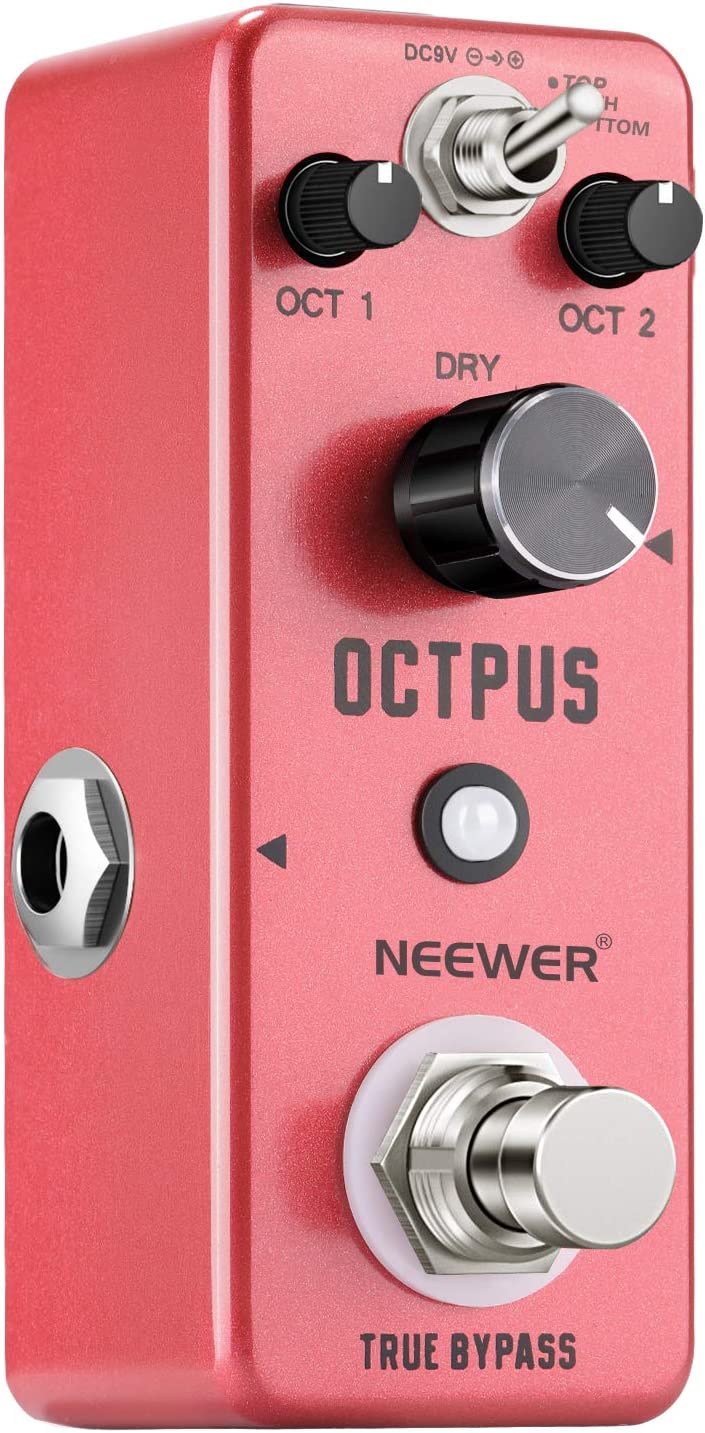
Neewer’s Digital Octave Guitar Effect Pedal is an advanced effects unit that adds versatile octave capabilities to your guitar setup.
Your original guitar tone stays intact with true bypass functionality when the pedal is non active.
In addition, you can choose from three distinct octave modes—Top, Both, or Bottom—tailoring the effect to your preferences.
This particular pedal has two operational modes, Normal and Fixed, which provide greater control over the pedal’s behavior.
Running on a 9-volt DC power supply, you’ll need an adapter to power the unit, as it’s not included.
Despite its advanced features, the pedal remains lightweight at just 0.61 pounds, making it a convenient addition to any pedalboard.
Featuring an analog signal format, this Neewer pedal delivers a warm, natural sound cherished by many guitarists.
Adjusting settings is a breeze thanks to the user-friendly knobs on the device.
In addition, the pedal offers a stylish Digital Octopus color and is designed with easy-to-use controls for a seamless playing experience.
- My Review
As a guitar enthusiast, I was excited to try the Neewer Digital Octave Guitar Effect Pedal.
I found that its advanced features and versatility truly enhanced my playing experience.
In addition, the true bypass functionality ensured that my original tone remained unaltered when the pedal was not in use, which is essential for maintaining a consistent sound.
One of the aspects I appreciated the most was the ability to choose between three different octave modes: Top, Both, and Bottom.
This allowed me to experiment with various sounds and find the perfect setting for my playing style.
In addition, the two operational modes, Normal and Fixed, also provided me with additional control and flexibility.
Although the 9-volt DC power supply adapter was not included, it was easy to find one and connect it to the pedal.
I was pleasantly surprised by how lightweight the pedal was, at just 0.61 pounds, making it convenient to add to my pedalboard without hassle.
I noticed that the analog signal format gave the pedal a warm and natural sound, which I prefer for my guitar tone.
In addition, the user-friendly knobs on the device made it simple to adjust the settings according to my preferences.
Here are the ratings I’ll give to the Neewer Digital Octave Guitar Effect Pedal:
One minor criticism is the color; although it doesn’t affect the performance, I would have preferred a more traditional color option.
Again, however, this is merely a matter of personal taste.
- Pros:
- Compact and lightweight.
- Three modes for greater versatility.
- True bypass technology preserves original tone.
- Cons:
- Adapter power supply not included.
- Limited control options with only knob.
My final verdict is that the Neewer Digital Octave Guitar Effect Pedal is a solid choice for guitarists looking for a compact and versatile pedal that can enhance their sound with advanced effects.
The pedal’s true bypass technology and three modes provide a good range of tonal options, while the compact and lightweight design makes it easy to transport.
The only drawbacks are the limited control options with only a knob and the fact that the power adapter is not included.
Considering its features and performance, the Neewer Digital Octave Guitar Effect Pedal offers good value for its price.
JHS Pedals 3 Series Octave Reverb Pedal
Explore ambient sounds with JHS Pedals 3 Series Octave Reverb.
The JHS Pedals 3 Series offers an affordable range of pedals with simple controls and quality construction. The Octave Reverb pedal recreates the iconic “Shimmer” effect, allowing players to layer in upper and lower octave sounds with the toggle switch. It runs on 9V DC Negative Centre power and consumes 65 mA.
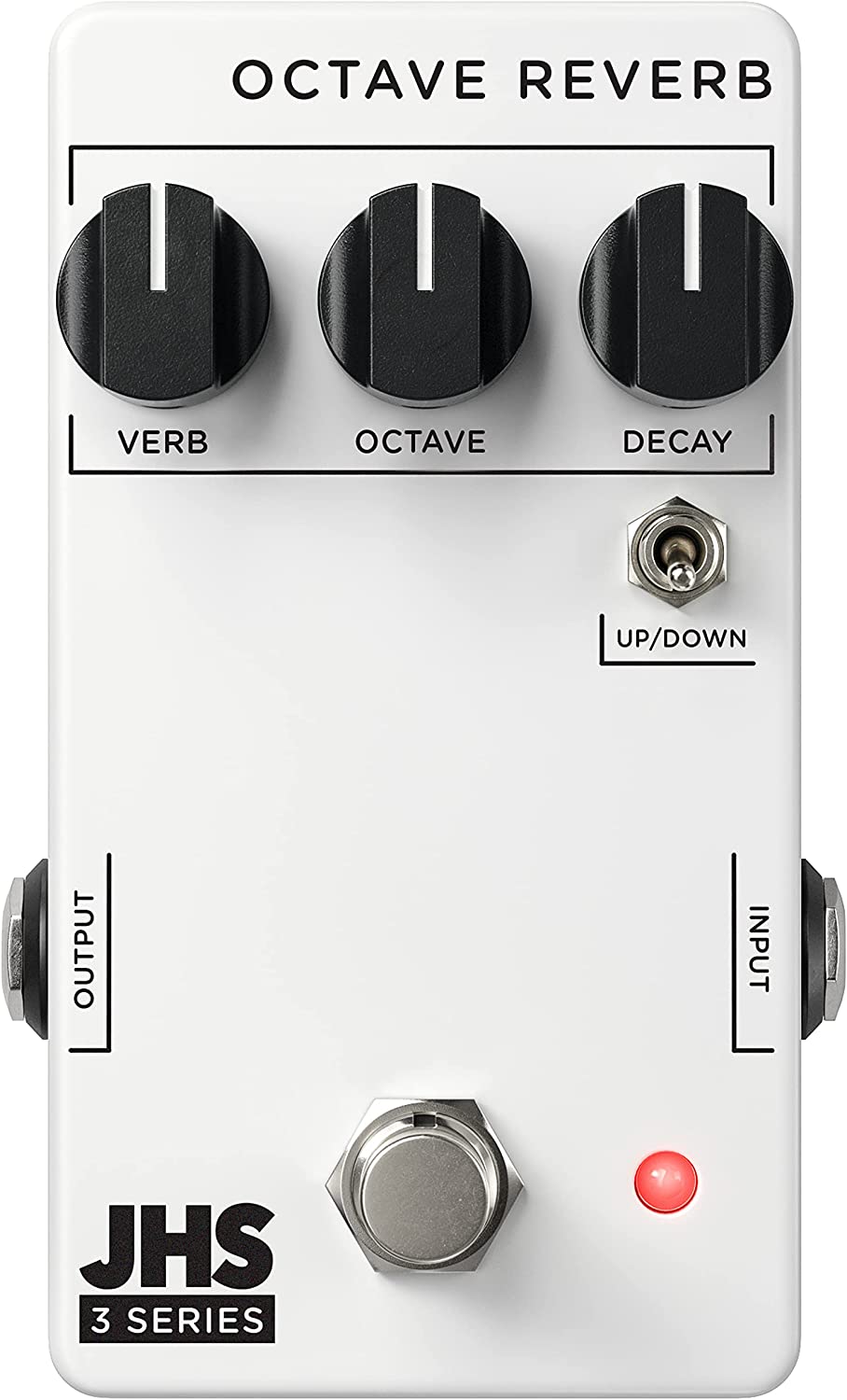
The JHS Pedals 3 Series Octave Reverb, or 3SOR, is a unique pedal that combines reverb and octave effects to create ambient pads and textures for guitarists.
This American-made pedal is inspired by Brian Eno’s famous “Shimmer” effect, which has been popular in music since the ’80s.
The 3SOR has a simple design with three knobs and a toggle switch, making it suitable for beginners and experienced musicians.
This pedal is part of JHS Pedals’ 3 Series, which offers affordable, high-quality effects pedals with a focus on simplicity.
Manufactured in Kansas City, Missouri, the 3 Series is known for its use of premium components and attention to detail.
The Octave Reverb operates on 9V DC negative center power and has a power consumption of 65 mA.
Featuring a white and black design, the 3SOR provides an analog signal format with 9 volts and an amperage of 65 milliamps.
The toggle switch allows users to layer either upper or lower octave sounds while the knobs control reverb level, octave level, and decay time.
- My Review
As an avid musician, I recently tried out the JHS Pedals 3 Series Octave Reverb (3SOR).
So naturally, I was eager to explore its features and capabilities, and I must say, I was pretty impressed with the overall performance of this pedal.
The 3SOR offers a unique combination of reverb and octave effects inspired by Brian Eno’s famous “Shimmer” effect, creating ambient textures and allowing the guitar to produce pads that fill out the sonic space.
The 3SOR has a simple design with three knobs and a toggle switch, making it easy for beginners and experienced guitarists.
The build quality is excellent, and it’s clear that JHS Pedals has put a lot of thought and care into constructing this pedal.
The Octave Reverb operates on 9V DC negative center power and has a power consumption of 65 mA, which is typical for effects pedals.
One of the features I appreciated most was the versatility of the 3SOR.
By adjusting the octave level and decay time, I experimented with various shimmer effects and used them as a short hall reverb.
The upper octave shimmer effect was particularly pleasing, especially when cranking the reverb and decay knobs to create dreamy, ethereal sounds.
However, there were a few limitations that I noticed.
The control over the shimmer effect felt somewhat restrictive compared to other pedals I’ve used, and I found the lower octave shimmer to be less prominent in the mix.
Additionally, the pedal does not have a power supply, which can be inconvenient for some users.
Here are the ratings I’ll give to the JHS Pedals 3 Series Octave Reverb Pedal:
Despite these minor drawbacks, the JHS Pedals 3 Series Octave Reverb is a worthy addition to any guitarist’s pedalboard.
Its affordability, simplicity, and overall sound quality make it a valuable tool for creating unique and mesmerizing soundscapes.
- Pros:
- Affordable price point
- High-quality parts
- Versatile sound options
- Toggle for upper/lower octave
- Good for harmonica
- Cons:
- Requires separate power supply
- Base reverb cannot be adjusted
- Shimmer “down” tone is hard to hear
- Octave not footswitchable
- Not good before gain stages
My final verdict is that the JHS Pedals 3 Series Octave Reverb is a solid choice for those looking for an affordable and versatile reverb pedal that offers a unique “shimmer” effect.
The pedal is well-built with high-quality parts and provides a compact design perfect for gigging musicians.
While there are a few drawbacks, such as the requirement for a separate power supply and the lack of a foot switchable octave, the pedal’s overall performance, tone, and value make it an awesome option for beginners and professionals.
I recommend this pedal to anyone looking for a versatile and affordable reverb pedal with a unique twist.
Electro-Harmonix Pitch Fork Pedal
Transform your 6-string guitar with Electro-Harmonix Pitch Fork.
The Electro-Harmonix Pitch Fork pedal turns your six-string guitar into a twelve or eighteen-string guitar with precise pitch shifting and expression pedal control. It offers glitch-free tracking, latch and momentary modes, and dry volume control for blending in your original signal.
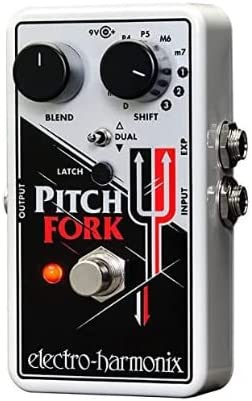
The Electro-Harmonix Pitch Fork is a compact, battery-powered pitch shifter pedal designed to expand the range of sound for guitarists.
This versatile device allows you to transform a standard 6-string guitar into something resembling a 12- or even 18-string instrument, opening up new sonic possibilities.
It also works well with bass guitars, adding depth to the low end and sparkle to the high end.
This pitch shifter offers a wide range of pitch-shifting options, from single note adjustments to double note shifts (simultaneously shifting up and down).
The device’s pitch-shifting range spans +/- three octaves, providing glitch-free tracking for fast playing.
In addition, it can achieve real-time pitch control and glissando effects with an expression pedal connected.
Additional features include a dry volume control for blending the original signal with the effect, latch and momentary modes for different footswitch and expression pedal behaviors, and true bypass to maintain signal integrity.
The Pitch Fork is powered by a 9V battery or the 9.6DC-200 power supply.
Combining the pedal with fuzz or distortion effects can create synth-like tones and rich, textured lows.
- My Review
After trying out the Electro-Harmonix Pitch Fork pitch shifter pedal, I can confidently say it’s a powerful and versatile tool for musicians looking to expand their sonic horizons.
It’s compact design and battery-powered operation made incorporating it into my pedalboard setup easy.
One of the standout features of the Pitch Fork is its ability to transform a 6-string guitar into a 12- or 18-string instrument or even emulate a synth.
In addition, I was impressed by the quality and variety of sounds I could achieve with this pedal.
The single-note and dual-note pitch shifting options allowed me to experiment with a wide range of musical intervals, and the +/- three-octave range meant that I could take my sound to soar new heights.
Connecting an expression pedal gave me more control over the pitch-shifting effects.
Real-time pitch control and glissando effects added a dynamic and expressive quality to my playing that was simply mesmerizing.
The dry volume control also proved helpful, as it let me blend the original signal with the effect to create harmony-rich tones.
While the Pitch Fork offers glitch-free tracking for fast playing, I noticed a slight learning curve when dialing in the perfect settings for my taste.
However, experimentation allowed me to find the sweet spot that suited my style.
Pairing the Pitch Fork with a fuzz or distortion pedal opened up even more creative possibilities, generating synth-like sounds and rich, gritty low-end tones.
Again, the true bypass feature ensured that my signal path remained intact when the pedal was disengaged.
Here are the ratings I’ll give to the Electro-Harmonix Pitch Fork Pedal:
In my experience, the Electro-Harmonix Pitch Fork is an impressive pitch shifter that delivers a wide array of unique and inspiring sounds.
Though it may take some time to master, the creative potential it offers is well worth the effort.
- Pros:
- Flexible pitch-shifting up to three octaves.
- Polyphonic tracking for chordal playing.
- Can be used with an expression pedal.
- Dry volume control allows for blend control.
- Cons:
- Battery power only option.
- No MIDI functionality.
- No presets to save settings.
My final verdict is that the Electro-Harmonix Pitch Fork is a highly versatile and feature-rich pitch-shifter pedal that offers a wide range of pitch-shifting options for guitarists and bassists.
Its polyphonic tracking and dry volume control features seamlessly integrate into any playing style or setup.
In addition, the option to use an expression pedal provides even more creative possibilities.
However, the lack of MIDI functionality and preset saving options may be limiting for some users.
The Electro-Harmonix Pitch Fork is an excellent choice for players looking to expand their tonal palette and experiment with new sounds.
MXR M288 Bass Octave Deluxe Pedal
Get an organic analog tone, Mid+ Switch and CHT (Constant Headroom Technology).
This bass octave pedal provides adjustable midrange control, allowing you to customize your tone with added depth and low-end power. Its easy-to-use design also includes a foot switch and LED indicator for effortless on/off switching.
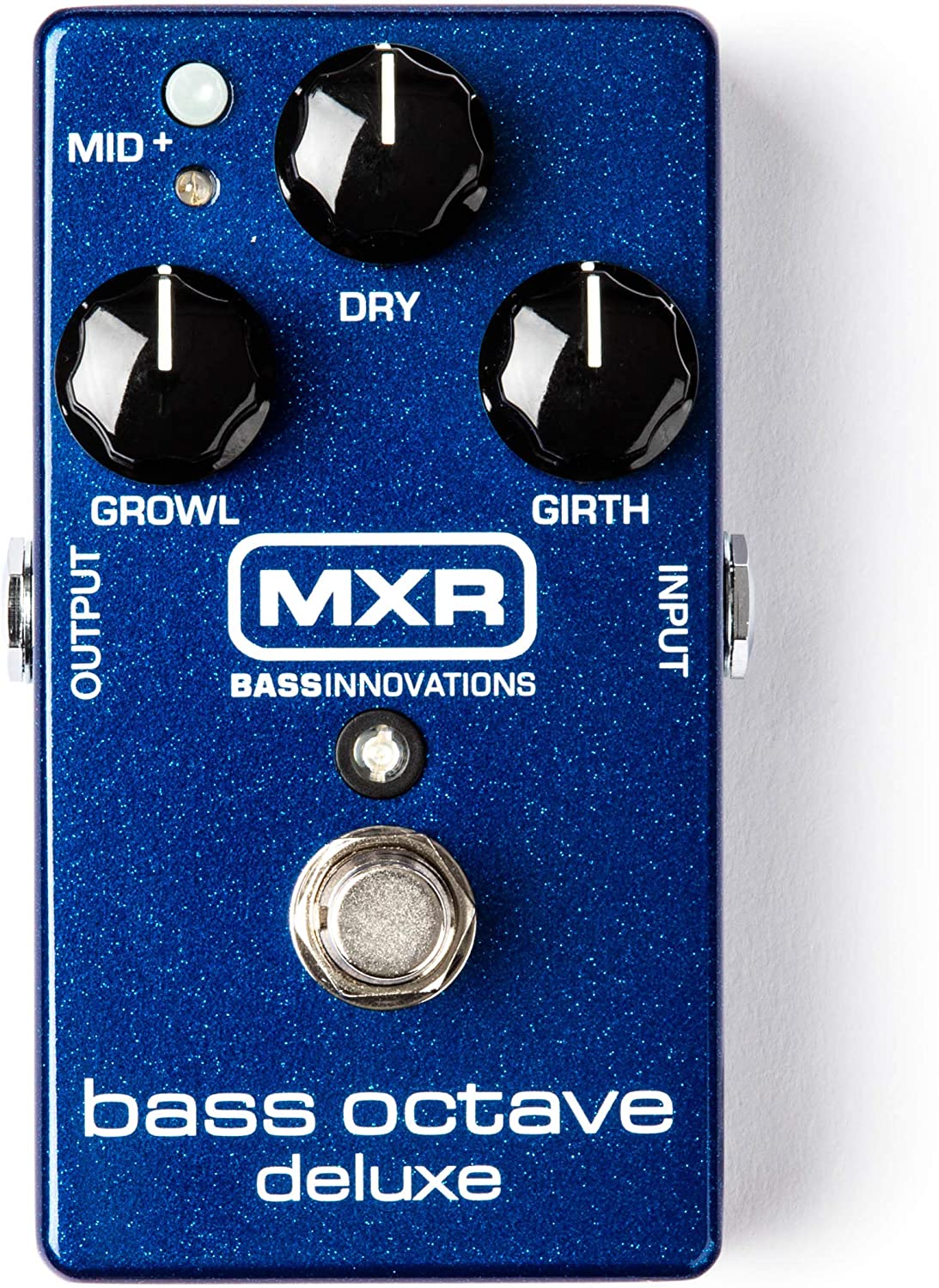
The MXR M288 Bass Octave Deluxe is a high-quality bass octave pedal designed by Jim Dunlop, offering players an organic analog tone to enhance their sound.
In addition, this pedal features Constant Headroom Technology (CHT), which ensures exceptional headroom and accurate tracking, making it stand out among other octave pedals.
One of the critical aspects of the M288 is its true bypass function, which preserves the integrity of your original signal when the pedal is not engaged.
It also boasts two independent octave voices, making it more versatile and customizable.
An exciting feature of this bass octave pedal is the adjustable Mid+ switch.
This enables users to boost the midrange frequency per their preference, adding another layer of tonal control.
As for its dimensions, the pedal measures 5.75 x 4.5 x 2.75 inches and weighs 272 grams, making it a compact and lightweight addition to your pedalboard.
The M288 operates on 18 volts with a current draw of 9 milliamps and has an analog signal format.
Its blue sparkle finish adds a touch of style to this reliable and robust bass octave pedal.
- My Review
I recently had the opportunity to test out this product and was impressed with its overall performance.
The product boasts a sleek and modern design, which looks great and is very functional.
In addition, its various features are user-friendly and straightforward, making it easy for anyone, regardless of their tech-savviness.
One of the standout features of the product is its efficiency.
It performs tasks quickly and effectively, making it a great addition to any home or office.
Additionally, it is compatible with various devices and software, allowing for seamless integration into existing systems.
The product’s durability is also impressive.
It is built to last, and I can see it being a reliable device for years.
While this product has many positives, there are a few areas where it could be improved.
For example, the product’s price point is slightly higher, making it less accessible for some consumers.
Additionally, some users may find the product’s learning curve steep, although this is a minor issue that can be overcome with practice.
Here are the ratings I’ll give to the MXR M288 Bass Octave Deluxe Pedal:
This product is an excellent investment for those seeking a reliable and efficient device to handle various tasks.
While it may not be the most affordable option on the market, its durability and functionality make it worth the investment.
- Pros:
- Exceptional headroom and tracking.
- True bypass.
- Organic analog tone.
- Two independent octave voices.
- Mid+ switch adds midrange boost.
- Cons:
- Tracking issues on low notes.
- Some find it too digital-sounding.
- Can be confusing to control.
- May sound muddy.
- Some quality control issues reported.
My final verdict is that the MXR M288 Bass Octave Deluxe is a versatile and feature-packed pedal that delivers exceptional analog tone and reliable performance.
Its constant headroom technology provides outstanding headroom and tracking, while the true bypass ensures your dry signal remains unaltered.
The pedal also boasts two independent octave voices, an adjustable midrange, and a mid+ switch that adds a midrange boost at a user-selected frequency.
The pedal’s sturdy build quality and compact size make it an excellent choice for gigging musicians, and its price point represents good value for the money.
While some reviewers have reported tracking issues with low frequencies, most users have found the pedal highly effective and capable of producing a range of rich, organic sounds.
I advise the MXR M288 Bass Octave Deluxe to any bass player looking for a high-quality octave pedal that delivers exceptional performance and versatility.
EarthQuaker Devices Rainbow Machine Pedal
Explore many new sonic possibilities.
Earthquaker Devices Rainbow Machine V2 is a polyphonic pitch mesmerizer designed for adventurers and noisemakers. It uses modern DSP to create real-time pitch shifting with digital oscillators for a unique sound. Features include primary, pitch, secondary, magic, tone, and tracking controls, plus a hand-built construction for reliable performance.
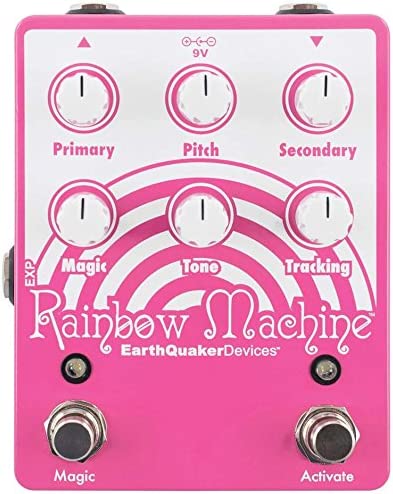
The EarthQuaker Devices Rainbow Machine V2 Polyphonic Pitch-Shifting Modulator Pedal is a unique and innovative guitar effects pedal for experimental and adventurous guitar players.
It features polyphonic pitch-shifting capabilities that allow players to create complex and interesting musical textures using digital oscillators.
The pedal also includes flexible control options for pitch and tone and a ‘magic’ control that adjusts the ‘weirdness’ of the effect, resulting in a wide variety of wild effects depending on where the other controls are set.
Additionally, the Rainbow Machine V2 offers a secondary pitch-shifted signal that can be controlled by its volume knob and an octave switch.
The pedal is hand-built and boasts a high-quality construction that ensures its durability and reliability.
While it may not suit those seeking more traditional or “natural” guitar sounds, this pedal is a great investment for musicians who value sonic exploration and creativity.
- My Review
I had the opportunity to try out the EarthQuaker Devices Rainbow Machine V2 Polyphonic Pitch-Shifting Modulator Pedal, and I must say, I was thoroughly impressed.
As an experimental guitar player, I was excited to see what kind of sounds I could create with this pedal, and it did not disappoint.
One of the standout features of the Rainbow Machine V2 is its polyphonic pitch-shifting capabilities.
With this pedal, I could create complex harmonies and interesting textures I had never heard before.
In addition, the flexible control options for pitch and tone allowed me to fine-tune my sound, and the ‘magic’ control added unpredictability, making playing with this pedal a truly exciting experience.
The secondary pitch-shifted signal was also a welcome addition, and I appreciated the ability to control its volume and octave switch separately.
It was easy to incorporate this signal into my playing and add another layer of depth to my sound.
The build quality of the pedal was also impressive.
I could tell that it was hand-built with care and felt sturdy and durable in my hands.
In addition, I had no issues with reliability during my time with the pedal.
One thing to note is that this pedal may not be suitable for those seeking more traditional or “natural” guitar sounds.
The Rainbow Machine V2 is about experimentation and pushing the boundaries of what is possible with guitar effects.
As a result, some players may find it difficult to control or may not appreciate the non-traditional sounds that it produces.
Additionally, the pedal is relatively expensive compared to others on the market, which may be a drawback for some.
Here are the ratings I’ll give to the EarthQuaker Devices Rainbow Machine Pedal:
- Pros:
- Unique and experimental sound.
- Polyphonic pitch-shifting capabilities.
- Flexible control options for pitch and tone.
- Cons:
- Not suitable for those seeking “natural” sounds.
- May be difficult to control for some players.
- Relatively expensive compared to other pedals.
My final verdict is that the EarthQuaker Devices Rainbow Machine V2 Polyphonic Pitch-Shifting Modulator Pedal is an excellent choice for experimental and adventurous guitar players looking for a unique and creative sound.
With its polyphonic pitch-shifting capabilities and flexible control options, this pedal offers a wide range of possibilities for creating complex and interesting musical textures.
While it may not be suitable for those seeking more traditional or “natural” guitar sounds, its innovative design and high-quality construction make it a great investment for musicians who value sonic exploration and creativity.
Overall, I would highly recommend the EarthQuaker Devices Rainbow Machine V2 to any guitar player looking to push the boundaries of their sound.
MXR M267 Octavio Fuzz Pedal
Legendary searing tones with touch-responsive octave-up saturation.
The MXR Octavio Fuzz brings the classic touch-responsive octave-up saturation to the MXR standard line. Create searing, synth-like tones with simple Output and Fuzz control settings, and let your playing dynamics bring out the pedal’s unique sounds.
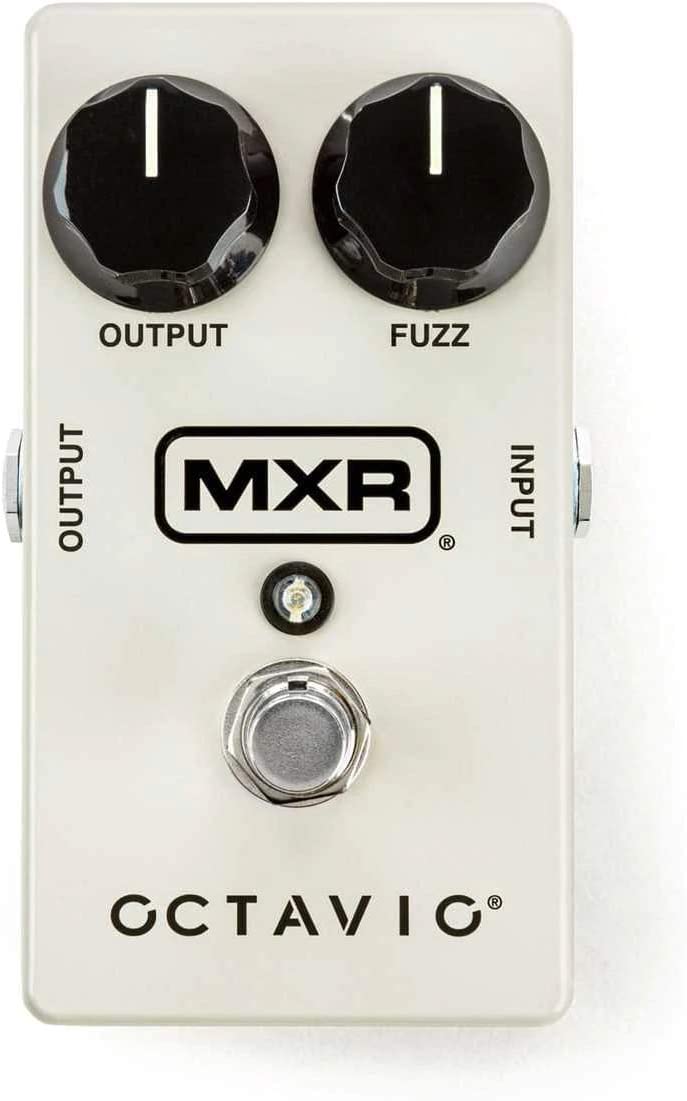
The MXR M267 Octavio Fuzz Pedal Bundle is a versatile effects pedal for guitar players looking to add unique and distinctive sounds to their music.
Its touch-responsive octave-up saturation feature delivers searing, synth-like tones that are perfect for modern players, from rockers to doom enthusiasts.
With a simple layout featuring only two controls – Output and Fuzz – this pedal is easy to use, allowing your picking and plucking dynamics to coax out the pedal’s legendary tones.
The bundle includes two high-quality patch cables and a 9-volt power supply, ensuring you have everything needed to start.
Built by MXR, a trusted and reliable brand in the music industry, this analog pedal delivers exceptional performance and tone.
It is compact, easy to take on the go, and runs on a standard 9-volt battery or power supply.
Whether you’re a beginner or a seasoned pro, the MXR M267 Octavio Fuzz Pedal Bundle is a great tool to add to your gear collection.
- My Review
After trying out the MXR M267 Octavio Fuzz Pedal Bundle with 2 MXR Patch Cables and Power Supply, I can confidently say this is a great product for guitar players who want to add some unique and interesting sounds to their music.
The touch-responsive octave-up saturation feature is the standout feature of this pedal.
It delivers many tones, from searing lead lines to fat and fuzzy chords.
In addition, I found that the Output and Fuzz controls were very easy to use, and I could dial in my desired intensity and volume quickly and easily.
One thing that impressed me about this bundle is that it comes with two high-quality patch cables and a 9-volt power supply.
These accessories are essential for any pedalboard, and it’s great to see that MXR included them in the package.
The pedal itself is built like a tank and feels very durable.
The compact size makes it easy to take on the go, and I found it fits nicely onto my pedalboard without taking up too much space.
I did notice that the pedal may not be compatible with certain guitar models, which could be a potential drawback for some users.
Additionally, the price point may be a bit high for some players on a budget.
In terms of value, I think that the MXR M267 Octavio Fuzz Pedal Bundle offers a lot for the price.
Here are the ratings I’ll give to the MXR M267 Octavio Fuzz Pedal:
The touch-responsive octave-up saturation feature is unique and sets this pedal apart from other fuzz pedals.
Including high-quality patch cables and a power supply is also a nice touch.
- Pros:
- Touch-responsive octave-up saturation
- Legendary searing, synth-like tones
- Simple layout with only 2 controls
- Comes with 2 high-quality patch cables
- Includes a 9 volt power supply
- Cons:
- May not be compatible with certain guitar models
My final verdict is that the MXR M267 Octavio Fuzz Pedal Bundle with 2 MXR Patch Cables and Power Supply is an excellent choice for guitar players looking to add touch-responsive octave-up saturation and legendary searing, synth-like tones to their sound.
With a simple layout featuring only two controls, this pedal is easy to use and offers exceptional performance.
In addition, the bundle includes high-quality patch cables and a 9-volt power supply, making it a good value for the price.
While the product may not be compatible with certain guitar models, this potential drawback is outweighed by the many pros of this product.
I highly recommend the MXR M267 Octavio Fuzz Pedal Bundle to guitar players looking to expand their tonal palette.
What exactly is an octave pedal?
An octave pedal is a specialized type of guitar effects pedal that alters the pitch of an input signal by adding one or more octaves above or below the original note, effectively expanding the instrument’s tonal range.
This versatile effect can be used in various musical styles, from rock and metal to jazz and blues, to add depth, texture, and complexity to a guitarist’s sound.
An octave pedal processes the incoming audio signal from a guitar.
It generates additional pitches, blended with the original signal to create a fuller, more harmonically rich sound.
This is achieved using digital signal processing (DSP) or analog circuitry, depending on the specific pedal design.

In digital octave pedals, the input signal is converted into a digital representation.
This is is then manipulated using algorithms that analyze the signal’s frequency content and generate new frequencies at octave intervals above or below the original note.
Once the additional octaves are created, the digital signal is converted back to an analog signal and mixed with the original input to produce the final output.
Analog octave pedals, on the other hand, use electronic components like flip-flops, diodes, and capacitors to generate additional octaves by doubling or halving the frequency of the input signal.
As a result, analog octave pedals tend to have a warmer, more organic sound.
However, they may suffer from tracking issues and a narrower range of pitch-shifting options than their digital counterparts.
The history of the octave pedal can be traced back to the development of early analog effects and the ongoing quest for innovative guitar tones.
Although the precise origins of the octave pedal are difficult to pinpoint, it is widely believed that the effect first emerged during the 1960s, a period marked by rapid advancements in music technology and experimentation with guitar sounds.
One of the first notable instances of an octave effect in popular music can be found in Jimi Hendrix’s use of the Roger Mayer Octavia, which he employed on classic tracks like “Purple Haze” and “Fire.”
The Octavia, designed by British engineer Roger Mayer, was an analog octave-up fuzz pedal that combined pitch-shifting with distortion, creating a distinctive, otherworldly tone.
Octavia’s innovative design and Hendrix’s groundbreaking use of the effect helped to popularize octave pedals and sparked the imagination of countless guitarists.
Today, the octave pedal market offers an impressive array of options, ranging from affordable compact pedals to feature-rich, high-end models.
In addition, many modern octave pedals combine digital technology with classic analog circuitry, providing guitarists with the best of both worlds.
Brands such as Electro-Harmonix, Boss, TC Electronic, and EarthQuaker Devices, among others, continue to push the boundaries of octave pedal design, offering users ever more creative and versatile tools for shaping their sound.
- When applied subtly, an octave pedal can add depth and richness to a guitar’s tone, filling out the lower or higher registers and creating a more expansive sound.
- When used more aggressively, the octave effect can add harmonic complexity and texture, giving the impression of multiple instruments playing simultaneously.
In addition to the tonal impact, octave pedals can inspire creativity and new approaches to playing.
Guitarists can discover new sonic possibilities and develop a unique, personalized sound by exploring different combinations of settings and incorporating the octave effect into various musical contexts.
What should you consider when choosing an octave pedal?
Selecting the right octave pedal for your needs is a crucial decision that can significantly impact your guitar’s tone and overall sound.
With numerous options available on the market, it is essential to consider various factors to ensure you make an informed choice.
We will explore eight key aspects to consider when choosing an octave pedal:
– Sound quality:
The primary concern when selecting an octave pedal should be its sound quality.
Consider how well the pedal tracks your playing dynamics and note changes, the pitch-shifting accuracy, and the effect’s overall tonal character.
Pay attention to any unwanted artifacts or noise the pedal introduces, as these can detract from your overall sound.
Additionally, test different octave pedals and compare their sound quality to identify the one best suits your preferences and requirements.
– Controls and features:
Another important aspect is the range of controls and features the pedal offers.
There are many features that you should look for, among some of them are:
- Octave shift: This control should allow you to select the direction and amount of pitch shifting, with options to shift up or down by one or two octaves or even more minute intervals.
- Dry/Wet mix: This knob should enable you to balance the original, unprocessed guitar (dry) with the pitch-shifted (wet) signal to your preference.
- Volume or gain: Some octave pedals may include individual volume or gain controls for the dry and wet signals, providing greater flexibility in shaping your tone.
- Tracking of response: This control should allow you to adjust how quickly the pedal reacts to your playing dynamics and note changes, with faster tracking offering more accurate and immediate octave effects.
By considering these features when selecting an octave pedal, you’ll be better equipped to find the perfect tool for your sonic exploration.
Remember that the interaction between your guitar, the octave pedal, and your amplifier plays a significant role in shaping the final sound, so don’t be afraid to experiment with different combinations and settings to achieve your desired tone.
– Analog vs. digital:
The debate between analog and digital octave pedals often concerns personal preference.
Analog pedals produce a warmer, more organic sound but may have limitations regarding tracking accuracy and pitch-shifting options.
Digital pedals offer improved tracking and a wider range of pitch-shifting possibilities but can sometimes sound less natural or “digital” than their analog counterparts.
If I were you, I’d just consider my tonal preferences and requirements when deciding between analog and digital octave pedals.
– Build quality and durability:
The build quality and durability of an octave pedal are crucial factors to consider, especially for those who plan to use the pedal extensively or in live performance settings.
It is important to look for a pedal that features a robust construction, solid switches, and durable knobs that can endure regular use and transportation.
For instance, opting for a pedal with a metal housing will typically offer greater durability compared to one with a plastic casing.
By choosing a well-built and reliable octave pedal, you can ensure consistent performance and longevity, allowing you to focus on creating captivating music.
– Presets and versatility:
Some octave pedals offer presets and additional functionality, such as MIDI compatibility or expression pedal inputs, that can provide even greater versatility in shaping your sound.
These features can be particularly useful for guitarists who require quick access to different settings or those who wish to integrate the octave pedal into a more complex effects setup.
Consider your specific needs and whether additional features or presets would benefit your case.
– Brand reputation:
Brand reputation, although not the only factor to consider, can offer valuable insights into the quality and reliability of an octave pedal.
Renowned brands like Electro-Harmonix, Boss, TC Electronic, and EarthQuaker Devices have earned their reputations by consistently producing high-quality and innovative octave pedals.
When selecting your pedal, it’s wise to research various brands and take their reputations into account.
By doing so, you’re more likely to choose a pedal that meets your needs in terms of performance, durability, and customer support, allowing you to enjoy your investment for years to come.
– Price and budget:
Price is always an important consideration when choosing any piece of musical equipment.
Octave pedals are available at different prices, from affordable entry-level options to high-end models with advanced features.
Determine your budget and compare the features and sound quality of different octave pedals within that price range to find the best value for your money.
Remember that while it is essential to stay within your budget, it may be worth investing in a higher-quality pedal that will provide better sound, durability, and performance in the long run.
– Reviews and recommendations:
Lastly, it is crucial to research reviews and recommendations from other guitarists and industry professionals when selecting an octave pedal.
Online forums, social media groups, and music gear websites often provide valuable insights into the pros and cons of specific pedals, user experiences, and suggestions.
Consult these sources to gain a broader understanding of the available options and identify potential issues or concerns that may not be immediately apparent.
How to properly use an octave pedal?
Proper use of an octave pedal can greatly enhance your guitar-playing experience, adding depth, texture, and complexity to your sound.
To achieve the best results, follow these four steps:
– Familiarize yourself with the controls and features:
Before using an octave pedal, it is essential to familiarize yourself with its controls and features.
Common controls include the octave shift, which allows you to choose the direction and amount of pitch shifting; the dry/wet mix, which lets you balance the original guitar signal with the pitch-shifted signal; and volume or gain controls for the dry and wet signals.
Some pedals may offer tracking or response controls that affect how quickly the pedal reacts to playing dynamics and note changes.
Spend time experimenting with these controls to understand how they impact the pedal’s sound and performance.
– Adjust the parameters to suit your musical goals:
Once familiarized with the pedal’s controls and features, you can adjust the parameters to suit your musical goals.
For example, if you want to add depth and warmth to your sound, you might want to focus on adding lower-octave effects.
Conversely, if you seek a more ethereal or shimmering tone, you could emphasize higher octave effects.
Additionally, consider the blend of the dry and wet signals, as this can significantly affect the overall tone and impact of the effect.
Adjust the volume or gain controls to ensure a proper balance between the original and pitch-shifted signals, and fine-tune the tracking or response settings to achieve the desired level of accuracy and responsiveness.
– Incorporate the octave pedal into your signal chain:
The placement of your octave pedal in your signal chain can have a substantial impact on the final sound.
Generally, octave pedals perform best when placed early in the signal chain, before other effects such as distortion, modulation, and delay.
This placement ensures that the octave pedal receives a clean, unprocessed signal from your guitar, which can improve tracking accuracy and minimize unwanted artifacts.
However, there are no strict rules regarding pedal placement, and you should experiment with different positions in your signal chain to find the best setup for your needs.
In addition, the interaction between various effects pedals can lead to unique and inspiring sounds, so don’t be afraid to explore unconventional signal chain configurations.
– Use the octave effect tastefully:
Finally, it is important to use the octave effect tastefully and in a manner that complements your overall sound and playing style.
When used subtly, octave pedals can add depth, richness, and harmonic complexity to your guitar’s tone without overpowering the original signal.
However, when used more aggressively, the octave effect can create a more dramatic and distinctive sound that may not be suitable for all musical contexts.
Therefore, be mindful of the settings you choose and how they impact your sound, and avoid overusing the octave effect to the point where it detracts from your playing or becomes a gimmick.
Instead, use the octave pedal to enhance your sound and inspire creativity while maintaining your unique guitarist voice.
How to order pedals on a pedalboard?
There is no one-size-fits-all approach to ordering pedals on a pedalboard, as the optimal arrangement largely depends on the specific sound you’re aiming for.
Usually, though, you will see guitar players mostly agreeing with this order:
Tuner > Filters/Dynamics > Pitch-based Effects > Overdrive/Distortion > Modulation > Time-based Effects > Looper
Aside from that, some general guidelines can help you achieve a balanced and versatile setup.
Let’s talk in detail about the order we just mentioned, but feel free to experiment and adjust to your own preferences:
- Tuner: Place your tuner pedal first to ensure your signal is in tune before passing through the other pedals.
- Filters and dynamics: Wah-wah, envelope filters, compressors, EQs, and noise gates should come next. These pedals affect your sound’s dynamic and tonal aspects, so it’s best to place them early in the chain.
- Pitch-based effects: Octavers, harmonizers, and pitch shifters should come after filters and dynamics since these pedals alter the pitch of your signal and work best with a clean, unprocessed sound.
- Overdrive and distortion: Overdrive, distortion, and fuzz pedals typically come next. They shape your guitar’s core sound, and placing them before most other effects ensures that those effects receive a strong, consistent signal.
- Modulation effects: Chorus, flanger, phaser, and tremolo pedals should be placed after overdrive and distortion effects. We do this to allow these pedals to add depth and movement to your sound without becoming overly distorted or overbearing.
- Time-based effects: Delay and reverb pedals should be placed towards the end of your signal chain. This allows them to create a sense of space and depth around the other effects, simulating the sound of a room or hall.
- Looper: If you use a looper pedal, it should be placed last in the chain. This ensures that you’re looping the entire signal, including all the effects you’ve applied.
Remember, these are just general guidelines and what generally works and sounds good.
The most important thing is to experiment and find the arrangement that best suits your personal sound and style.
For example, here’s one pedalboard signal chain that I always use:
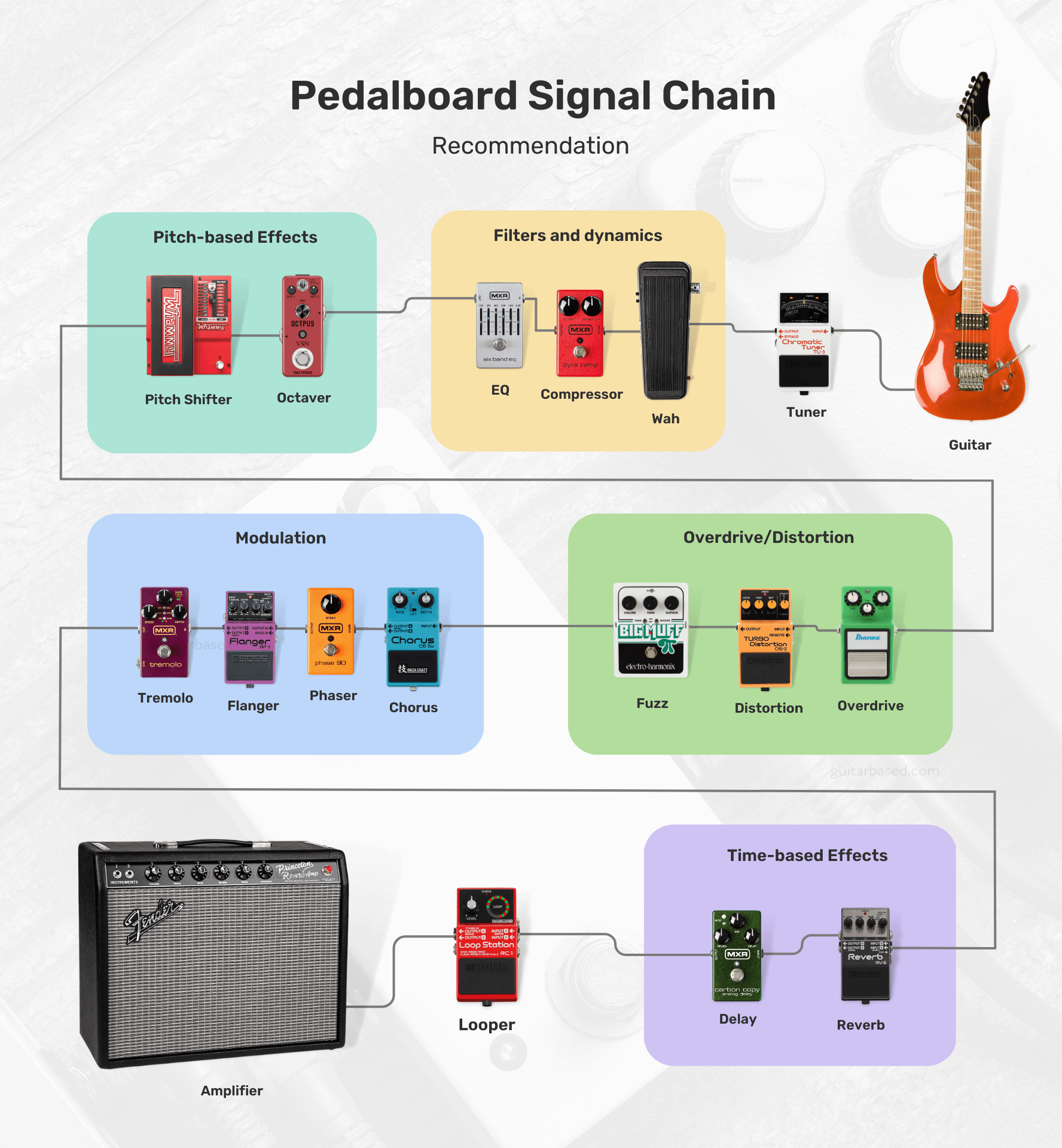
Feel free to swap the order of pedals, try different combinations, and test out unconventional setups until you find the one that works best for you.
For those interested, I’ll leave you with most of the possibilities that you’ll encounter and how to order them.
- Tuner
- Filters/Dynamics:
- Volume
- Wah
- Auto-Wah
- Compressor
- Noise Gate
- EQ (Equalizer)
- Pitch-based Effects:
- Octaver
- Harmonizer
- Pitch Shifter
- Overdrive/Distortion/Fuzz:
- Boost
- Overdrive
- Distortion
- Fuzz
- Modulation:
- Chorus
- Phaser
- Flanger
- Univibe
- Vibrato
- Tremolo
- Time-based Effects:
- Delay
- Echo
- Reverb
- Synth/Bitcrusher:
- Synth
- Bitcrusher
- Acoustic Simulator
- Multi-Effects
- Utility:
- Buffer
- A/B/Y Switcher
- MIDI Controllers
- Looper
Boutique vs. Mass-Produced pedals
Boutique pedals are generally built with higher-quality components and craftsmanship, resulting in better durability and longevity.
These pedals often feature unique and innovative designs, providing a wider range of tones and effects that may not be available in mass-produced options.
Here are a few examples of boutique pedals:

All the manufacturers also tend to have a more personal approach, with better customer service and the ability to customize pedals according to the user’s preferences.
However, boutique pedals are usually more expensive due to the smaller scale of production and the use of premium components.
Mass-produced pedals, on the other hand, are more affordable due to their larger scale of production and the use of cost-effective components.
These pedals are widely available and offer a range of popular effects, making them accessible to a larger audience.
Here are a few examples of mass-produced pedals:

The quality control for mass-produced pedals can vary depending on the brand and model, but many are reliable and offer good value for the money.
As for one of the downsides, you’ll find that mass-produced pedals may not have the same level of uniqueness or innovation as boutique options.
On the other hand, they may not provide the same level of customer service or customization options.
The choice between boutique and mass-produced pedals depends on your personal preferences, budget, and desired sound.
If you’re looking for unique tones, higher-quality components, and a more personal experience, boutique pedals may be the way to go.
But I would say, for those who are on a budget and need access to popular effects, mass-produced pedals might be a better fit.
It’s worth trying out both types to see which best suits your needs and playing style.
How much should you spend on a guitar pedal?
If I were in your position, I would first determine my budget and specific needs before deciding how much to spend on a guitar pedal.
For beginners, it might be more reasonable to start with affordable, mass-produced pedals to explore different effects without spending too much.
Guitar pedals can range in price from around $30 to over $400, depending on the brand, quality, and complexity of the effect.
As your skills and understanding of your preferred tone develop, you can gradually upgrade to higher-quality or boutique pedals.
One thing I would do is consider which effects are essential to your playing style and prioritize purchasing those first.
Allocating a larger portion of your budget to the most important pedals might be a wise choice, especially if you only need a few basic effects.
However, if you require a wide array of effects, you may want to consider more budget-friendly options or multi-effects units.
Keep in mind that higher-priced pedals often come with better build quality, unique features, and improved sound quality.
But I would also say that price is not always directly correlated with quality or suitability for your needs.
Sometimes, a more affordable pedal can deliver the exact sound you’re looking for, while a higher-priced option might not meet your expectations and are only expensive because of the brand reputation.
Can you use a guitar pedal with a bass guitar?
You can certainly use a guitar pedal with a bass guitar.
But it’s crucial to be aware that some guitar pedals may not be specifically designed to accommodate the frequency range of a bass guitar.
This could result in a less-than-ideal performance or an altered tone that might not be what you were expecting.
If you’re feeling adventurous and eager to experiment with your sound, don’t hesitate to connect your guitar pedals to your bass guitar.
This can be a fun way to explore different sonic possibilities, and you might even stumble upon some unique tones that complement your playing style perfectly.
Using a guitar pedal with a bass guitar may not always produce the desired results.
In some cases, the low-end frequencies might be lost, or the effect could sound too harsh or muddy.
To avoid these issues, you could consider looking into pedals that are specifically designed for bass guitars.
These pedals are engineered with the bass frequency range in mind, ensuring that your low-end remains intact and the effect sounds as intended.
In addition to bass-specific pedals, there are also multi-effects processors and pedals that cater to both guitar and bass players, offering a wide range of effects and tonal options.
These versatile units can be a great solution if you play both instruments and want a single device to cover your needs.
How to properly power your pedals?
When it comes to powering your pedals, you want to make sure you’re doing it right to avoid any noise issues or potential damage.
First, check each pedal’s power requirements, which you can usually find in the manual or on the pedal itself.
You’ll want to pay attention to the voltage (usually 9V, 12V, or 18V) and current (measured in milliamps or mA).
Now, you’ve got a few options for powering your pedals.
You can use individual power supplies or batteries for each pedal, but that can get messy and inconvenient.
I’d recommend going for a pedal power supply or an isolated power brick.

For example here are a few ones I recommend:
- Voodoo Lab Pedal Power 2 Plus Isolated Power Supply (My favorite)
- Rowin PW-1 Guitar Pedal Power Supply (Cheapest)
These babies can power multiple pedals at once, and the isolated outputs help prevent noise and ground loop issues.
Just make sure the power supply you choose can handle the voltage and current requirements of all your pedals.
When you’re connecting everything, use good quality power cables and keep them neat and tidy to avoid a tangled mess.
You might even want to use cable ties or cable organizers to keep everything in order.
In love with guitars, and gear; expert in all things music! Been writing about guitars for about 5 years and counting. Born in the ’90s. Alma Mater: University of Havana. Always curious, trying to understand the world. #TeamFender

